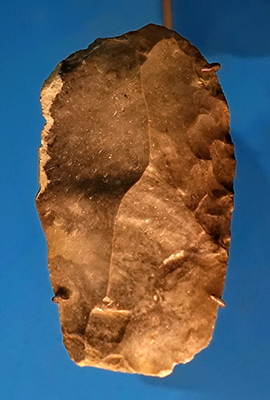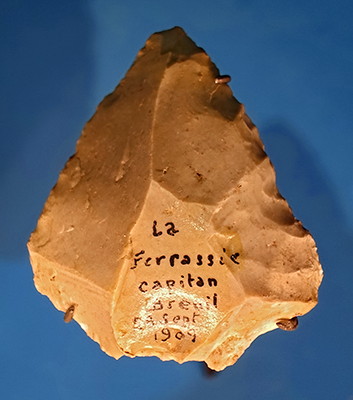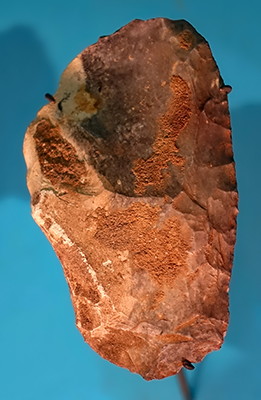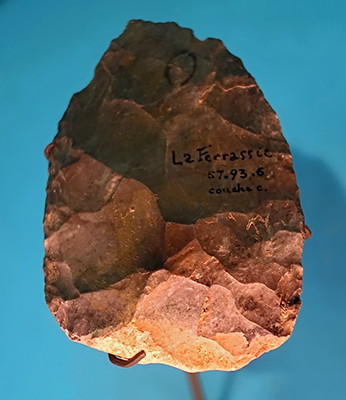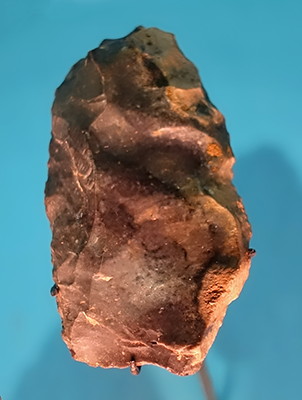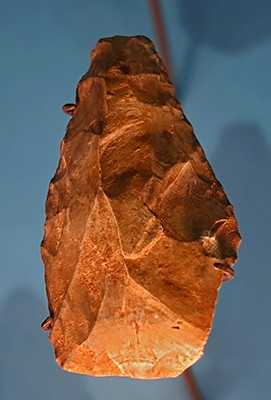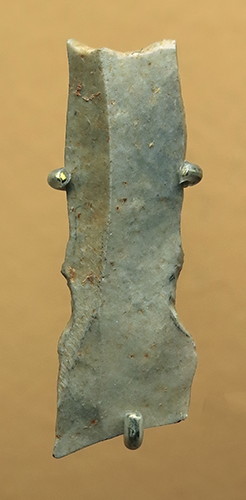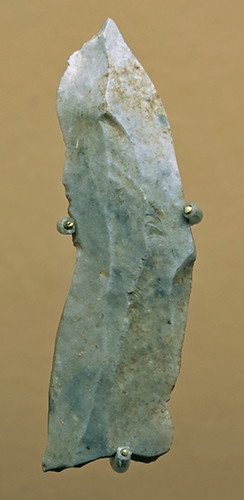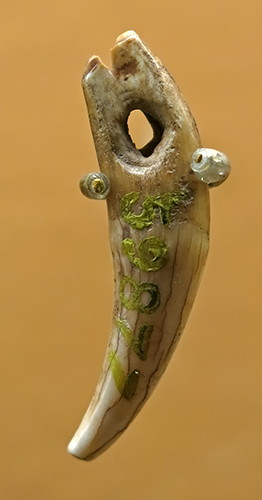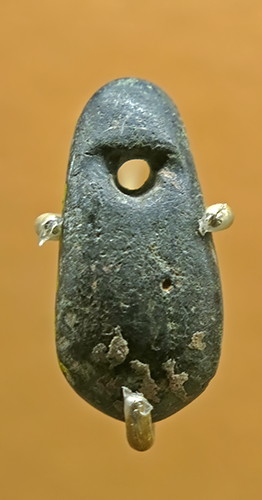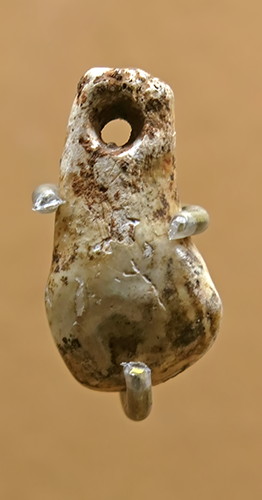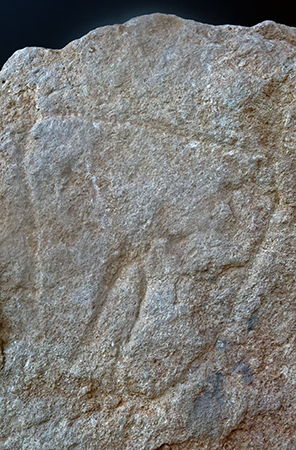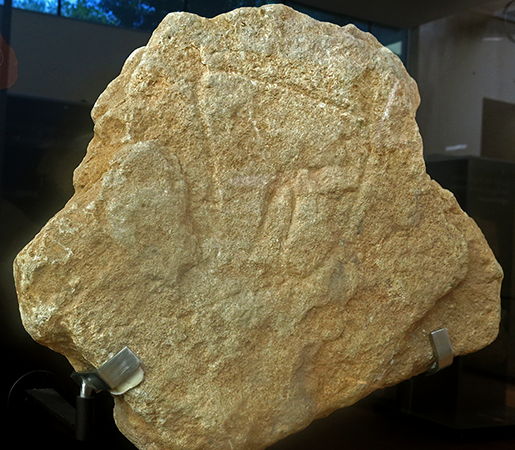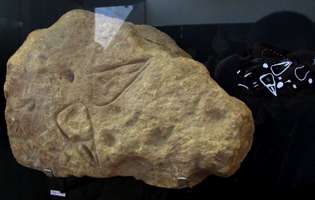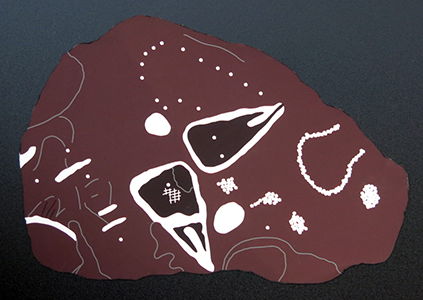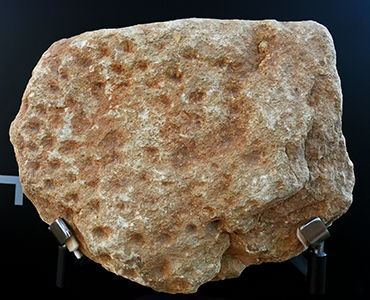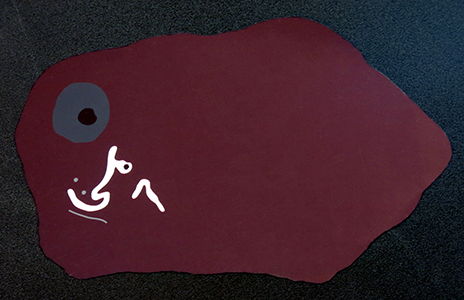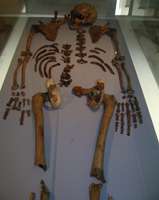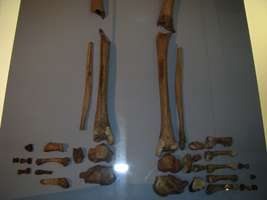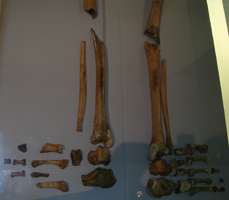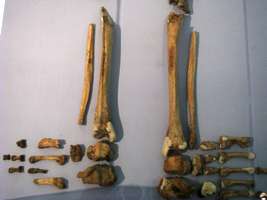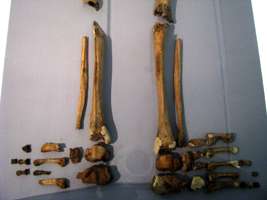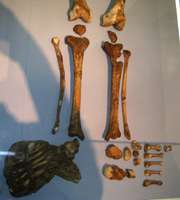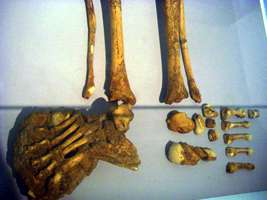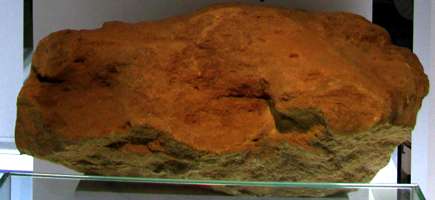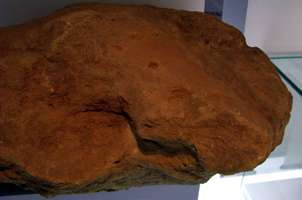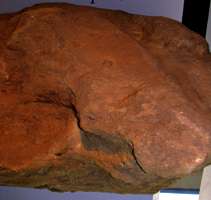Back to Don's Maps
 Mousterian (Neanderthal) Sites
Mousterian (Neanderthal) Sites Back to the review of hominins
Back to the review of hominins
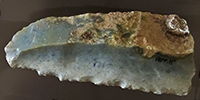 Tools of La Ferrassie - in detail
Tools of La Ferrassie - in detailLa Ferrassie Cave or Abri - a Neanderthal rock shelter
La Ferrassie rock shelter yielded skeletons from eight Neanderthal individuals, including adults, children, infants, and two fetuses. Today the skeleton of La Ferrassie 1 is considered the classic example of Neanderthal anatomy. It was discovered on 17th September 1909 by R. Capitan and D. Peyrony.

La Ferrassie is on the inside of a curve in the road at approximately 44.9514N, 0.9379E.


La Ferrassie Cave or Abri - a Neanderthal rock shelter
It should be realised that the original back surface of the shelter is the solid rock on the left half of the photograph, and the vertical wall on the right is the remains of the sediments which were excavated to expose the surface upon which the group of people are standing.
La Ferrassie 1 and 2 were found at about the place where the modern sign is in these panoramas.
Photo: Don Hitchcock 2008
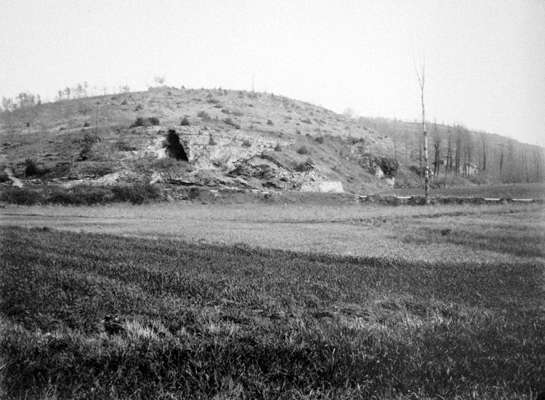
This is an early photograph of La Ferrassie, denuded of vegetation, presumably by goats.
My thanks to M. Jean-Pierre Chadelle for his help in the identification of this photograph.
Photo: MNP, display at Musée National de Préhistoire, Les Eyzies
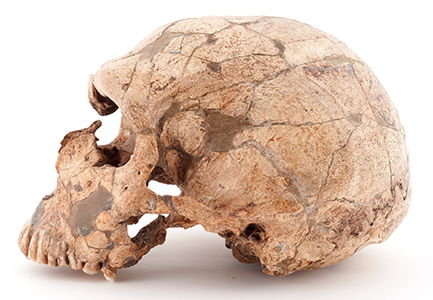
Skull of Ferrrassie I, the old man of Ferrassie.
Photo: © Jc Domenech
Source: https://storify.com/public/templates/slideshow/index.html?src=//storify.com/franceinter/visite-virtuelle-du-musee-de-l-homme#19
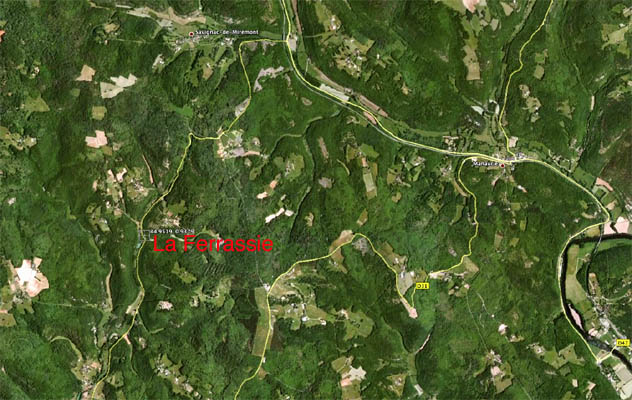
La Ferrassie is on the inside of a curve in the road at approximately 44.9514N, 0.9379E.
Photo: Google Earth
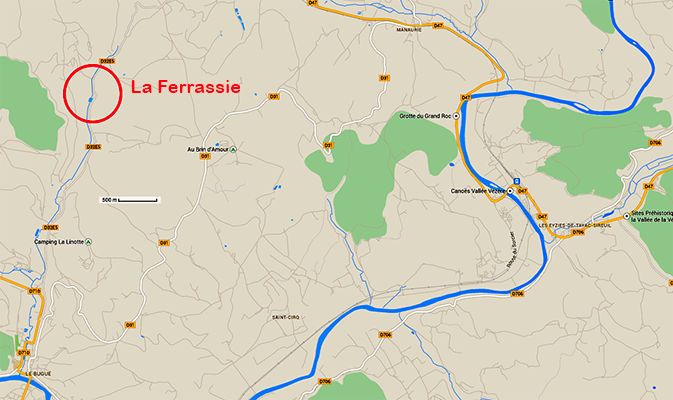
La Ferrassie is 4 km north of Le Bugue and 6 km west of Les Eyzies.
Photo: Google Maps

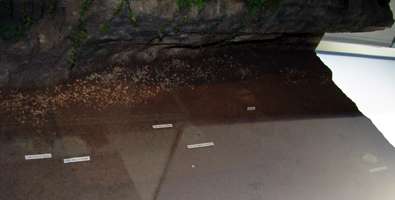
A diorama of the La Ferrassie Rock Shelter.
Photo: Don Hitchcock 2008
Source: Display at Musée National de Préhistoire, Les Eyzies
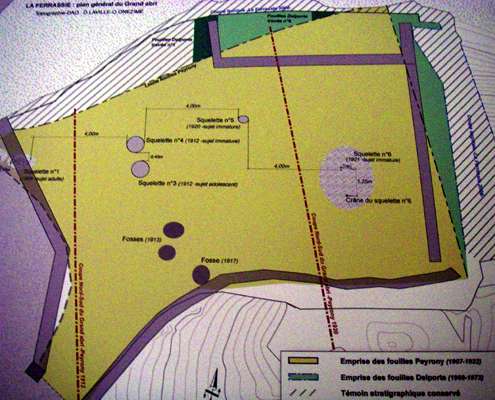
Map of the La Ferrassie burial plots.
Photo: Don Hitchcock 2008
Source: Display at Musée National de Préhistoire, Les Eyzies
The discovery of La Ferrassie I, the old man of La Ferrassie.
Translated and adapted by Don Hitchcock from the French.
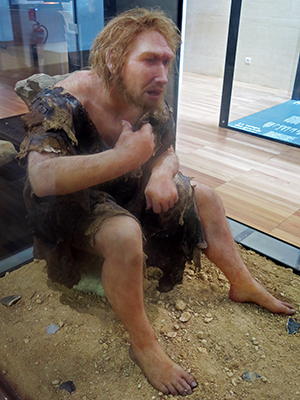
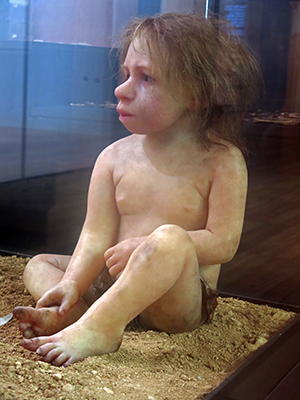

Neandertal models, beautifully crafted. The child is listening to the man attentively.
The sculptor was not credited, but it is the work of Élisabeth Daynès. The adult is based on La Ferrassie I.
The child is based on the three year old found at Roc de Marsal.
It is a superb work, a real tour de force by a master sculptor.
This is not just an illustration for a museum, it is a work of art suitable for any display of the best work that humans are capable of. I am in awe of the talents and artistry of Élisabeth Daynès. She is a world treasure.
Photo: Don Hitchcock 2014
Source: Display at Musée National de Préhistoire, Les Eyzies
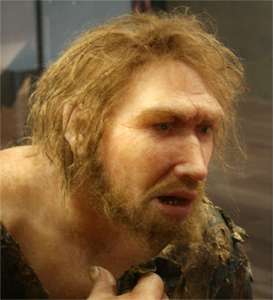
Close up of the head of the model of La Ferrassie I.
Photo: http://s1.zetaboards.com/anthroscape/topic/2448167/1/
Ferrrassie I, the old man of Ferrassie.
Photo: Don Hitchcock 2018
Collections du Muséum national d'Histoire naturelle, Paris
Source and text: Musée de l'Homme, Paris
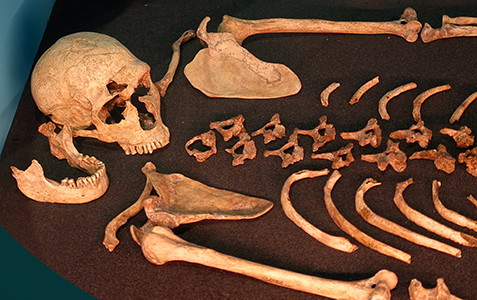
Close up of the head and torso of Ferrrassie I, the old man of Ferrassie.
Photo: Don Hitchcock 2018
Collections du Muséum national d'Histoire naturelle, Paris
Source and text: Musée de l'Homme, Paris
Last September one of us (Peyrony) accompanied by M. Raveau (from Bordeaux) saw two bones slightly protruding out of the wall of the dig, between the first and the second layer (counting from below), that is to say between the Acheulean and the Mousterian. The earth was removed from over them, and they were easily recognised as two human tibias.
We contacted our friends Professors Ball, Cartailhac, Breuil, who came to our aid. MM. Feaux, Bouyssonie and Bardon joined them. On September 27, after careful study of the conditions of the deposit, and after having noted that the layers were completely intact, we proceeded, in their presence and with their concurrence, to cut successive horizontal slices - each corresponding to an archeological level - and on an area of 4 square meters, removing first the overburden, then the archeological layers, following the cut as follows:
| 6. | Gravel and humus | 120cm |
| 5 | Scree elements, sometimes large. Between and on these rocks, upper Aurignacian deposits interspersed. | 100cm |
| 4. | Middle Aurignacian. | 50cm |
| 3. | Lower Aurignacian | 20cm |
| 2. | Location of the Mousterian skeleton | 50cm |
| 1 | Acheulean | 50cm |
The deposits were carefully excavated layer by layer, an easy task because of their quite different colourings.
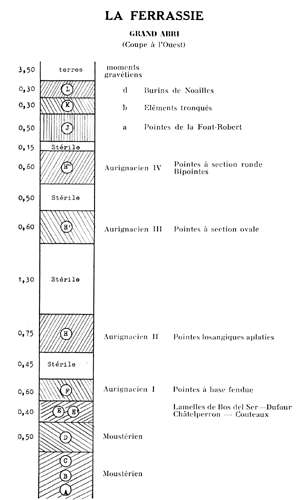
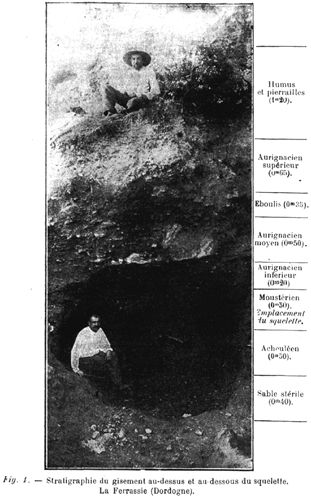
La Ferrassie stratigraphy
Photo (left): Cheynier (1960)
Photo (right): Capitan and Peyrony (1910)
Photographer (right): Almost certainly Monsieur Lucas, l'institution aux Eyzies
Probably Denis Peyrony at the base of the cut.

Section of the strata at La Ferrassie.
Photo: Keith (1915)
Proximal source: archive.org
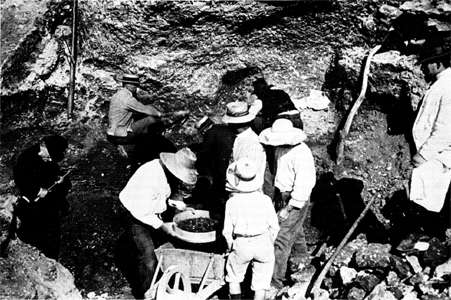
Major discoveries.
In 1909, La Ferrassie.
Discovery of the Neanderthal skeleton by Denis Peyrony (standing centre, wearing a straw hat with coloured ribbon). On the left, holding a rod, Emile Cartailhac. At the back, Marcellin Boule, wearing a straw hat, and Abbé Breuil, in shirtsleeves, vest and black hat.
Photo: Pales (1962)
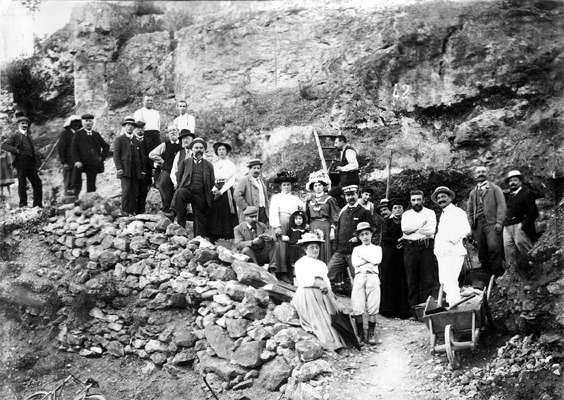
Probably Denis Peyrony second from the right, hatless, with the handlebar moustache, wearing the same clothes as in a photograph at a similar time, 1908, at le Cellier.
Photo: http://albuga.free.fr/en/prehistoire/heim/main.html
We also recovered a large number of flint pieces, of worked stone, bones and teeth of animals eaten by the people who lived here, and, enclosed in sand, earth and ashes, the traces of their residence extending to this point.
The industry and fauna of each zone have different characteristics from those of other layers. Thus, knife-scrapers and thick Mousterian blades follow chisels, scrapers and thin well retouched blades which have notches in the Aurignacian, but in the Mousterian notches are entirely absent. Similarly, while bison, deer, and horse (characterising a regime of grasslands and forests) are abundant in the Mousterian and reindeer (indicating a landscape of icy plains) are rare, they become more numerous in the Aurignacian, while other animals greatly diminish.
When we had thus removed all the layers, from the overlying scree to layer 2 (Mousterian), we retrieved three flat stones of about 20cm across, one placed near the skull and the other two at about the level of the arms. On the surface corresponding to the skeleton, in the sandy soil of a reddish brown colour, in the archeological layer, there were, in far greater numbers than in other parts of the same level, large splinters of animal bone, carrying on the outer faces traces of hammering at one, or sometimes two points on a surface of 2 to 3 centimetres square.**
** (footnote) We can not help but think of the pebbles hammered in the same way at one or two points which M. Chatellier has reported in a very large number of Breton megalithic burials.
This layer also contained a large number of very well retouched flints (points, scraper-knives and discs) characteristic of the Lower Mousterian age as well as pebbles of quartz serving as hammers or bone smashers. The same pieces were found around, on and below the skeleton, but this latter level was blended with those of the underlying layer containing more axes of the type of St. Acheul.
We then proceeded with great slowness and infinite precautions, starting with the lower limbs, with a veritable dissection of the skeleton, just freeing the bones but leaving them in place. Thus advancing step by step, the complete skeleton appeared to us then just as it had been laid down by its contemporaries, the Mousterian, extended on the back, the trunk slightly inclined to the left, legs very strongly folded under the thighs, the latter half bent over the pelvis, knees turned to the right, the left arm along the body, left hand at the left hip, right arm bent and the right hand near the shoulder, head turned left, jaw wide open.
All bones of the skeleton, sometimes broken by the enormous weight of the earth covering them were in place in their corect anatomical place, and still solid. Only the bones of the foot and right hand had been moved, probably by a small carnivore, a rodent, and partly removed.
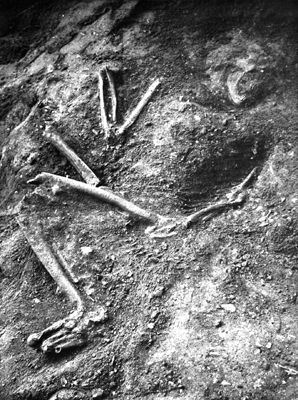
View of the skeleton at the time it was found. It was lying on the Acheulean beds, surrounded and covered by Mousterian deposits.
(It is important to realise that the skeleton had not been buried, but had been simply placed on the surface of the ground, perhaps with some rudimentary covering, possibly including branches, hides and earth - Don.)
Photo: Capitan and Peyrony (1910)
Photographer: Almost certainly Monsieur Lucas, l'institution aux Eyzies
All findings having been minutely recorded, and photographs taken, we removed the limb bones with great care.
Then, having dug a deep groove around the pelvis, we covered up the bones with tin foil and a thick covering of plaster. Then slowly digging lower and beneath the skeleton, we could remove it as a whole.
The same operation allowed us to extract what was left of the chest, then thirdly - and with special care - the skull and a large volume of earth around and below it, the whole thing surrounded by a strong shell of plaster.
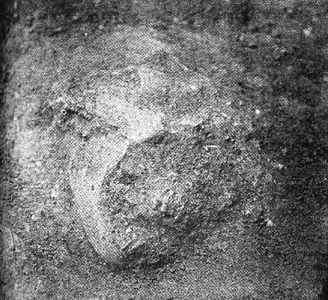
View of the head in position, before removal.
Photo: Capitan and Peyrony (1910)
Photographer: Almost certainly Monsieur Lucas, l'institution aux Eyzies
These various parts could then be reassembled without a single piece lost, since all the surrounding earth remained in contact with the find until the time of preparation in the laboratory. This is the first time this method, identical to that used by paleontologists, has been employed for the recovery of fossil human bones.
It is also the first time a skeleton this old, found in its correct stratigraphic position, could be photographed precisely and indisputably accurately at the time of its disinterment and before any manipulation.
(Regarding this claim, it should be noted that a photograph in situ of the neanderthal skull found at La Chapelle aux Saints had been taken by l'abbé Jean Bouyssonie in August of 1908.
See The Neandertal skeleton from La Chapelle-aux-Saints - Don.)
We had long talks with our learned friends to establish the conditions that prevailed during the interment of this body. We have been unanimous in rejecting the idea of accidental death in this place, the corpse being left on site. Nothing in the field indicates a collapse of the abri at that time, when there was one very large shelter. Neither could the corpse have been simply left there on the floor of the abri after death, since it would have been quickly and inevitably devoured by hyenas.
We believe that there must have been a funeral rite. The corpse had been placed in a corner of the shelter on a portion of the soil sloping slightly towards the wall and near the wall. The soil was formed by the debris and household detritus of the previous inhabitants, the Acheulean. (It had a yellow color while that which surrounded the skeleton was reddish brown.)
The corpse had its strong legs folded, following probably the same ritual that Negroid skeletons of lower layers of the Menton grotte des enfants. (the 'children's cave' at Mentone, on the border between France and Italy- Don.) The three stones of which we spoke earlier, had perhaps been placed intentionally, one on the head and two on the shoulders. Perhaps also, the hammered animal bones had been intentionally placed on him, according to a special rite. He had then been covered, perhaps with branches, or hides, perhaps with a little dirt and debris from the soil. But he had certainly not been buried in a pit.
Protected by the proximity of Mousterians living in the shelter, he was not disturbed, except by small carnivores or rodents, which scattered the bones of the foot and the right hand. Gradually the debris of people using the shelter (earth, ashes, splinters of bone and flint pebbles) spread over him like the rest of the shelter, and were likely spread by the comings and goings of the inhabitants of the cave. Thus was formed above him a perfectly regular stratification of archeological deposits, as in the rest of the shelter and in succession from age to age, according to human evolution in this place. Under this heavy and unchanging shroud, the skeleton was preserved. The fallen ceiling of the abri and the successive following deposits finished this conservation work that has enabled us to regain our old ancestor so prodigiously, exactly in the position where his contemporaries had been so many centuries ago. **
** (footnote) We accompany this communication with prints of 13 photographs taken in the course of our excavations, which we have given to the President of the Society.
(Note: I would dearly like to have access to those 13 photographs. If anyone knows how I can obtain good copies of them, please contact me - Don.)
Original text above: Capitan and Peyrony (1912)
Translated and adapted by Don Hitchcock from the French.

Homo neanderthalensis, discovered 1909.
La Ferrassie 1 & Co. reconstruction.
Circa 50 000 BP.
Adult, 172 cm tall, circa 85 kg, skull capacity 1600 cm3
Long, flattish skull with elongated occipital area. Large front teeth, molars with enlarged pulp chamber.
Receding chin, narrow, slightly protruding cheekbones, flattish face, large nasal opening, low forehead with discrete brow ridges.
Stocky and robust build, adapted to cold climates, preferred a diet high in meat.
Photo: Don Hitchcock 2015
Source and text: Facsimile, Vienna Natural History Museum, Naturhistorisches Museum Wien
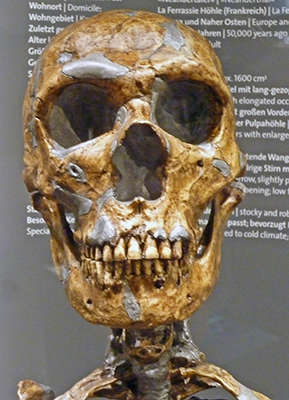

La Ferrassie skeleton reconstruction - skull.
Photo: Ralph Frenken 2013
Source: Museum of Natural History, Vienna, Austria
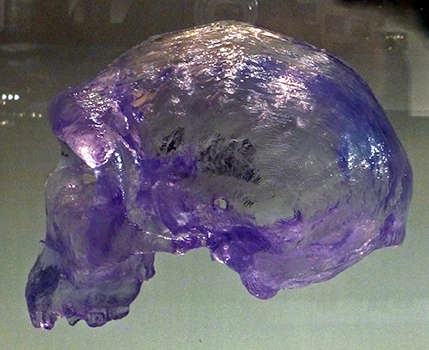
La Ferrassie 1, partial cranium stereolithograph.
Ca 74 000 - 50 000 BP.
The process of 3D printing is set to revolutionise the displays available in museums around the world. All that has to be done is that the skull or other artefact is scanned, that file may be sent anywhere in the world, and the recipient then prints the object using a 3D printer, which are increasingly common and dropping in price all the time. This means that anyone can have a superb quality archaeological specimen at negligible cost.
However, the subsequent colouring of the stereolithograph to create an opaque and realistic looking specimen still, at the moment, requires the skills of an artist trained in this field.
Photo: Ralph Frenken 2013
Source: Museum of Natural History, Vienna, Austria

Paired right clavicles (cranial view) and humeri (anterior view) for Late Pleistocene humans.
Neandertals: La Ferrassie 1 (Ferr1) and Regourdou 1 (Reg1).
Upper Paleolithic modern humans: Dolní Věstonice 13 (DV13), Pataud 5 (Pat5), and Sunghir 1 (Su1).
Note that for all clavicle–humerus pairs except Regourdou 1, both bone images derive from the same original photograph, and hence there is no issue of scaling distortion.
Photo and text: Trinkaus et al. (2014)

La Ferrassie stratigraphy after D. Peyrony.
Cross section 1:
A. Limestone gravel containing some cordate handaxes and coarse industry flakes.
B. yellowish limestone sand deposit.
C. Rich Mousterian level.
D. Mousterian level separated in the middle by a pavement of limestone blocks.
E. Red clay runoff with Mousterian tools and Châtelperronian points (Inferior Perigordian).
F. reddish brown horizon containing an Aurignacian industry including bone spear points with split bases.
H. Aurignacian industry with flattened diamond-shaped bone points.
J. Layer with a Font-Robert (Superior Perigordian) industry .
N. Calcareous scree.
Photo and text for these two cross sections:
Peyrony (1934), in Groenen (1994)
Cross Section 2:
A. Poor archaeological level.
B. Calcareous sand.
C. Mousterian.
D. Calcareous screes.
E. Reddish clay layer with Mousterian pieces and Châtelperronian points (Inferior Perigordian).
F. Aurignacian bone spear points with a split base .
H. Aurignacian flattened diamond-shaped bone spear points.
H '. Aurignacian spear points with a slender oval section.
H''. Aurignacian biconical (formed like two cones joined base to base - Don) or fusiform (formed like a spindle, wider in the middle and tapering toward the ends- Don) spear points in bone.
J. Level Industrial Perigordian higher.
K. Layer with truncated pieces with and retouched back.
L. Layer with blades, scrapers and Noailles burins.
M. Scree (talus) and limestone boulders.
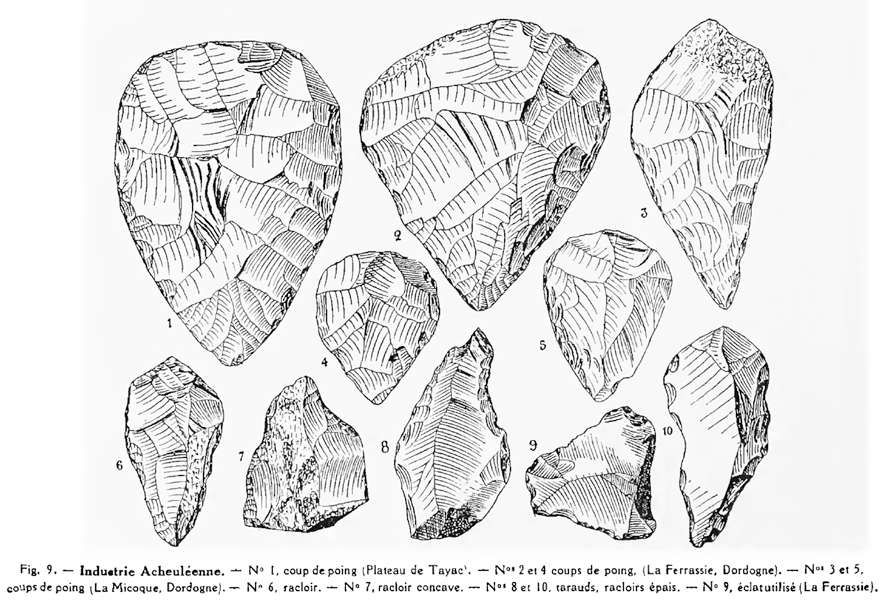
Acheulian industry - No. 1 coup de poing (Plateau de Tayac) A coup de poing is a cordate handaxe, the swiss army knife of early man.
Nos 2 and 4 coup de poing from La Ferrassie
Nos 3 and 5 coups de poing from La Micoque
The following all from La Ferrassie:
No 6 racloir
No 7 concave racloir, scraper
Nos 8 and 10 borers on one end, thick racloirs/scrapers on the other
No 9, worked flake
Photo: Peyrony (1914)
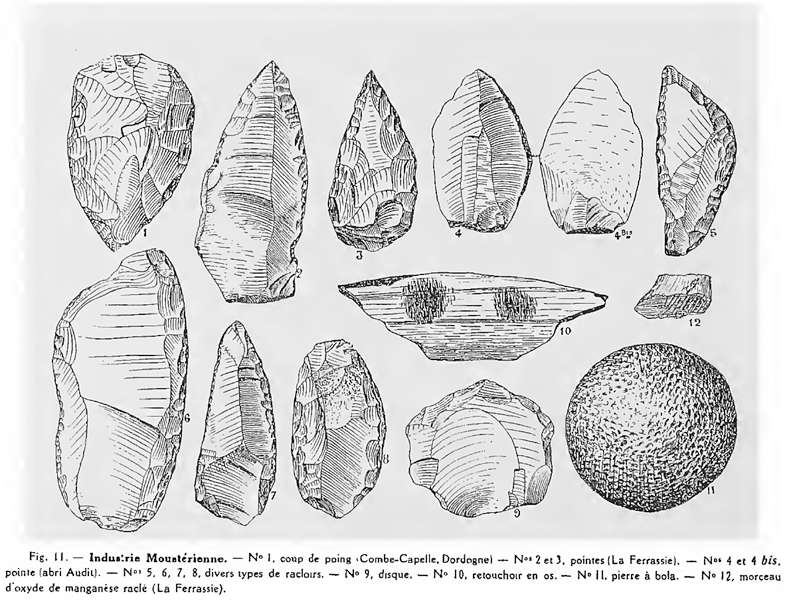
Mousterian Industry
No 1 coup de poing, cordate or heart shaped hand axe, Combe-Capelle
Nos 2 and 3 points, La Ferrassie
Nos 4 and 4 bis (other side ) point from Abri Audit (or Abri Audi, near Les Eyzies )
The following all from La Ferrassie:
Nos 5, 6, 7, 8 various types of racloirs
No 9 disk
No 10 bone retoucher
No 11 bola stone (a bola is a weapon for bringing down game, consisting of two or more stones joined by cord, which when thrown wraps around the legs of the game - Don )
No 12 piece of Manganese Dioxide
Photo: Peyrony (1914)
Tools from La Ferrassie.
Individual tools were not identified in this case from the exhibition, but the six shown here come from the list below, and the reader is invited to make the appropriate identifications!
Levallois flake
Grattoir / side scraper
Levallois point
Point / flake
Racloir / grattoir, side scraper / end scraper
Biface
Flint, circa 100 000 BP - 40 000 BP
Photo: Don Hitchcock 2018
Collections du Muséum national d'Histoire naturelle, Paris
Source and text: Musée de l'Homme, Paris
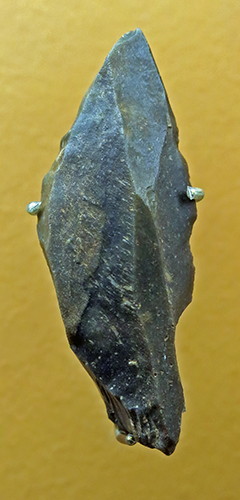

Burins.
From the L, K, J Gravettian layers of La Ferrassie.
Photo: Don Hitchcock 2015, 2018
Source and text: Original, Musée d'Archeologie Nationale et Domaine, St-Germain-en-Laye
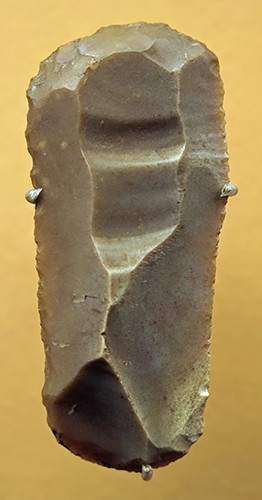
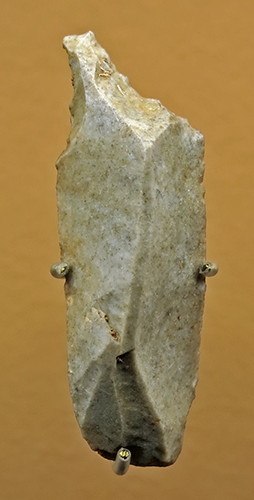
(left):Grattoir, scraper.
(right): Perçoir, drill.
From the L, K, J Gravettian layers of La Ferrassie.
Photo: Don Hitchcock 2015
Source and text: Original, Musée d'Archeologie Nationale et Domaine, St-Germain-en-Laye
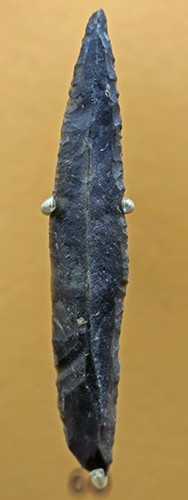
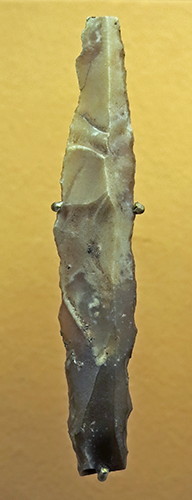

Gravettian points.
From the L, K, J Gravettian layers of La Ferrassie.
Photo: Don Hitchcock 2015
Source and text: Original, Musée d'Archeologie Nationale et Domaine, St-Germain-en-Laye
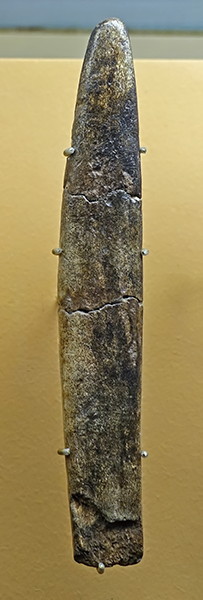
Biseau, or bevel.
From the L, K, J Gravettian layers of La Ferrassie.
( Biseaux, or bevels, were used for heavy duty splitting of bone, antler and ivory. They were longer and thicker than ciseaux, or wedges, which were used for finer work removing the blanks for, say, needles from a bone. See below - Don )
Photo: Don Hitchcock 2018
Source and text: Original, Musée d'Archeologie Nationale et Domaine, St-Germain-en-Laye
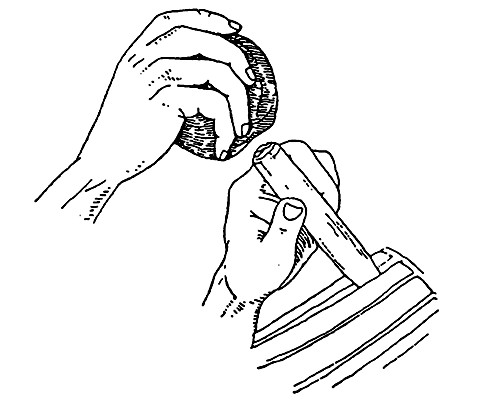
Extraction of a rod from an ivory tusk by inserting a bevel into a groove.
Photo and text: Camps-Fabrer et al. (1998)

Spear point with a simple pointed base.
From the L, K, J Gravettian layers of La Ferrassie.
Photo: Don Hitchcock 2015
Source and text: Original, Musée d'Archeologie Nationale et Domaine, St-Germain-en-Laye
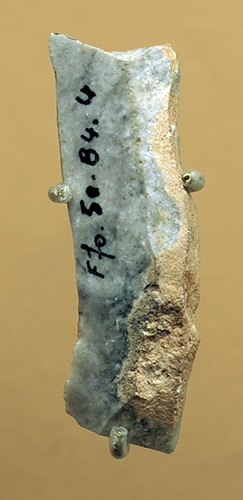
Noailles burins.
From the L, K, J Gravettian layers of La Ferrassie.
Photo: Don Hitchcock 2015
Source and text: Original, Musée d'Archeologie Nationale et Domaine, St-Germain-en-Laye
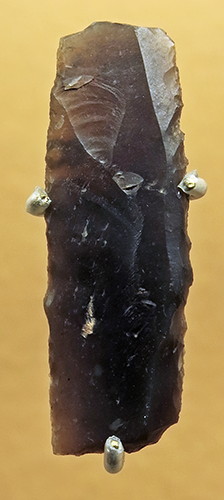
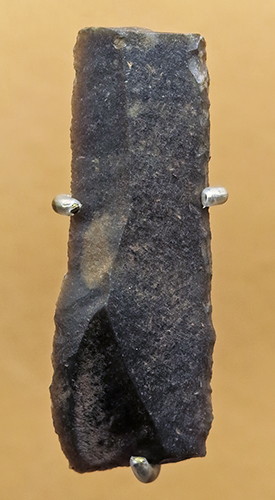
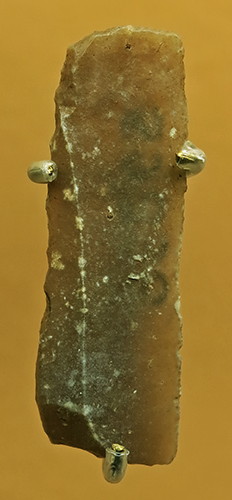
Truncated blades.
From the L, K, J Gravettian layers of La Ferrassie.
Photo: Don Hitchcock 2015
Source and text: Original, Musée d'Archeologie Nationale et Domaine, St-Germain-en-Laye
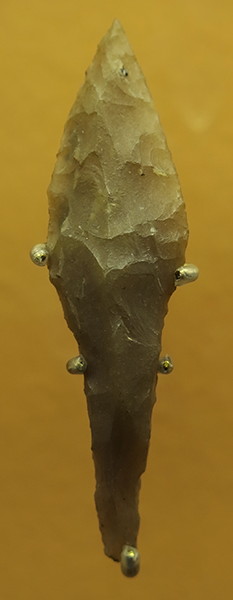
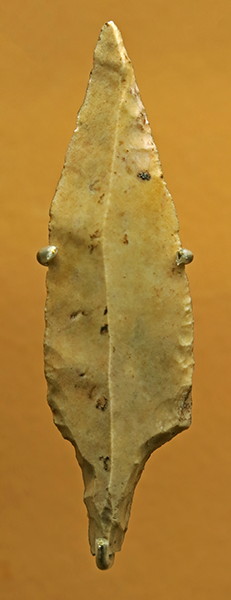
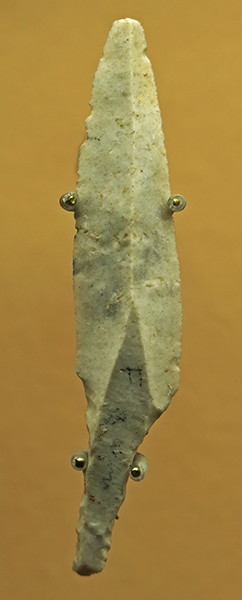
Font-Robert points.
From the L, K, J Gravettian layers of La Ferrassie.
Photo: Don Hitchcock 2015
Source and text: Original, Musée d'Archeologie Nationale et Domaine, St-Germain-en-Laye
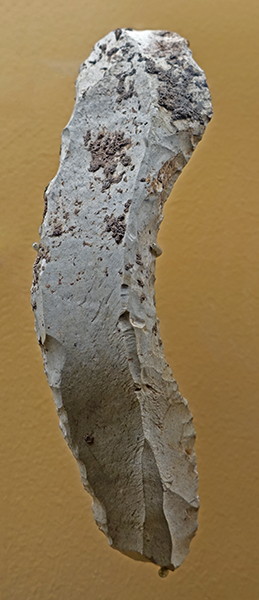
Aurignacian blade.
From the H and F Aurignacian layers of La Ferrassie.
Photo: Don Hitchcock 2018
Source and text: Original, Musée d'Archeologie Nationale et Domaine, St-Germain-en-Laye

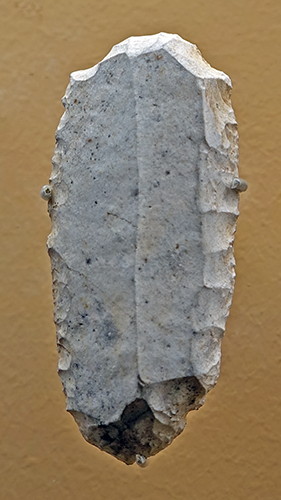
(left): Grattoir caréné, keeled scraper.
(right): Double ended scraper.
From the H and F Aurignacian layers of La Ferrassie.
Photo: Don Hitchcock 2018
Source and text: Original, Musée d'Archeologie Nationale et Domaine, St-Germain-en-Laye
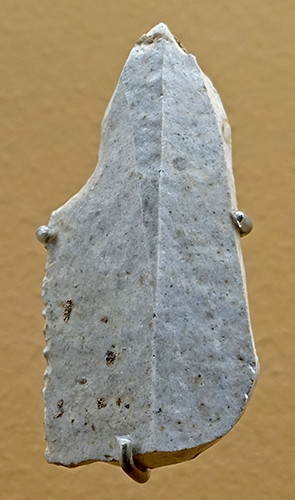
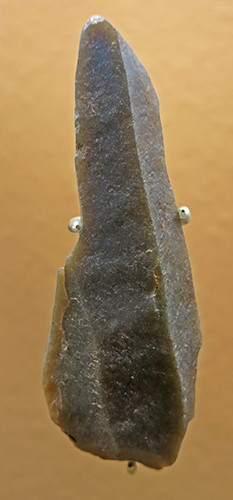
Burins.
From the H and F Aurignacian layers of La Ferrassie.
Photo: Don Hitchcock 2018, 2015
Source and text: Original, Musée d'Archeologie Nationale et Domaine, St-Germain-en-Laye


(left): Perçoir, drill.
(right): Poinçon, awl. ( a bird bone has been used for the awl, which would have only required grinding down and polishing to a sharp point to become a very useful tool - Don )
From the H and F Aurignacian layers of La Ferrassie.
Photo: Don Hitchcock 2018, 2015
Source and text: Original, Musée d'Archeologie Nationale et Domaine, St-Germain-en-Laye

Biseau, or bevel, used to split off baguettes or rods from antler, bone, and ivory.
From the H and F Aurignacian layers of La Ferrassie.
Photo: Don Hitchcock 2015
Source and text: Original, Musée d'Archeologie Nationale et Domaine, St-Germain-en-Laye


Rhombic spear points.
From the H and F Aurignacian layers of La Ferrassie.
Photo: Don Hitchcock 2018, 2015
Source and text: Original, Musée d'Archeologie Nationale et Domaine, St-Germain-en-Laye

Spear point with a split base.
From the H and F Aurignacian layers of La Ferrassie.
Photo: Don Hitchcock 2015
Source and text: Original, Musée d'Archeologie Nationale et Domaine, St-Germain-en-Laye


(left): Engraved tube.
(right): Engraved rod.
From the H and F Aurignacian layers of La Ferrassie.
Photo: Don Hitchcock 2015
Source and text: Original, Musée d'Archeologie Nationale et Domaine, St-Germain-en-Laye
(left): Carnivore tooth, possibly from a cave bear, drilled.
(centre): Stone bead, drilled.
(right): tooth, possibly from a deer, drilled.
From the H and F Aurignacian layers of La Ferrassie.
Photo: Don Hitchcock 2015
Source: Original, Musée d'Archeologie Nationale et Domaine, St-Germain-en-Laye
Additional text: Don Hitchcock
The Châtelperronian
Age circa 45 000 to 40 000 BP, named after the site of Grotte des Fées, in Châtelperron, Allier, France.
The Châtelperronian represents a lead up to the Aurignacian from the Mousterian, and combines elements of both. The artefacts may have been made by Neandertals in contact with Cro-Magnon peoples. It is the earliest part of the French Perigordian, which in that classification leads to the Gravettian. The industry produced denticulate stone tools and also a distinctive flint knife with a single cutting edge and a blunt, curved back. The use of ivory at Châtelperronian sites appears to be more frequent than that of the later Aurignacian, while antler tools have not been found.
(text above adapted from Wikipedia)
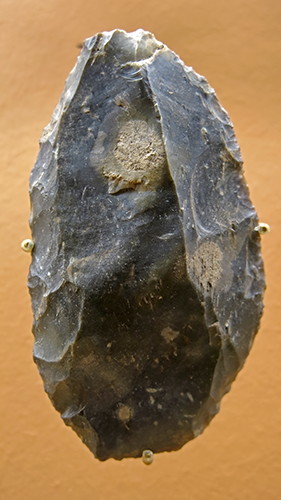
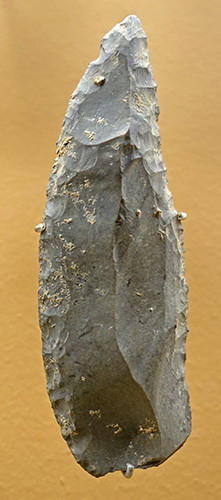
(left): Racloir double, double edged side scraper.
(right): Point.
From the E Châtelperronian layer of La Ferrassie.
Photo: Don Hitchcock 2015
Source: Original, Musée d'Archeologie Nationale et Domaine, St-Germain-en-Laye
Additional text: Don Hitchcock
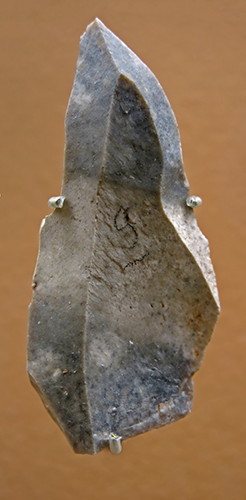
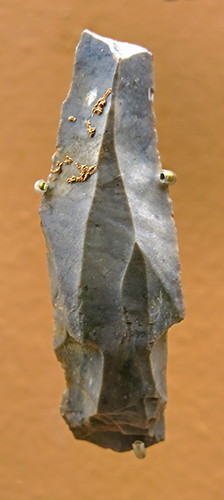
Burins.
From the E Châtelperronian layer of La Ferrassie.
Photo: Don Hitchcock 2015
Source: Original, Musée d'Archeologie Nationale et Domaine, St-Germain-en-Laye
Additional text: Don Hitchcock
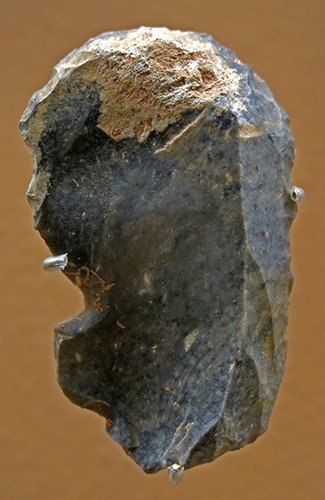
Grattoir, scraper.
From the E Châtelperronian layer of La Ferrassie.
( note the notch taken out of one side of the scraper. These were used to smooth and shape spear shafts - Don )
Photo: Don Hitchcock 2015
Source: Original, Musée d'Archeologie Nationale et Domaine, St-Germain-en-Laye
Additional text: Don Hitchcock
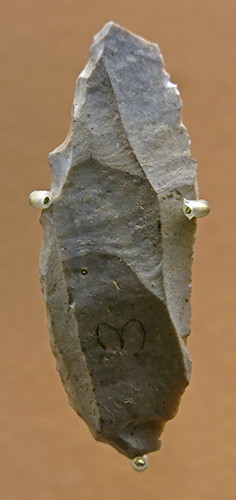
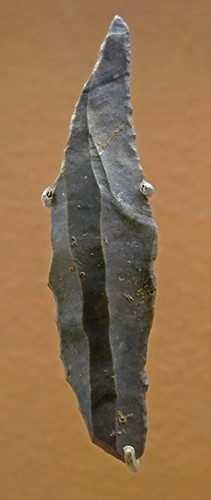
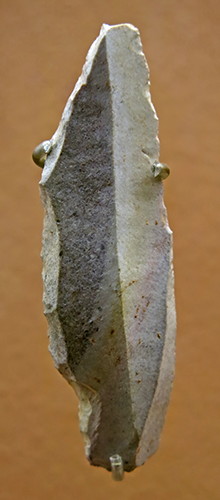
Châtelperronian Points.
From the E Châtelperronian layer of La Ferrassie.
Photo: Don Hitchcock 2015
Source: Original, Musée d'Archeologie Nationale et Domaine, St-Germain-en-Laye
Additional text: Don Hitchcock
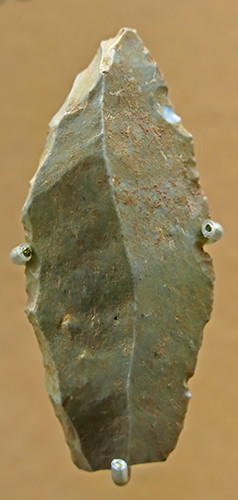
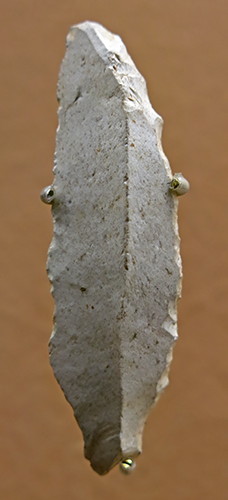
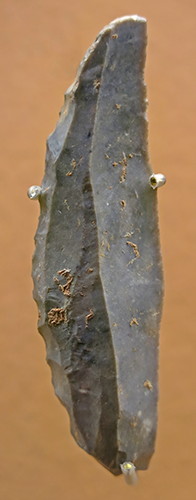
Châtelperronian Points.
From the E Châtelperronian layer of La Ferrassie.
Photo: Don Hitchcock 2015
Source: Original, Musée d'Archeologie Nationale et Domaine, St-Germain-en-Laye
Additional text: Don Hitchcock
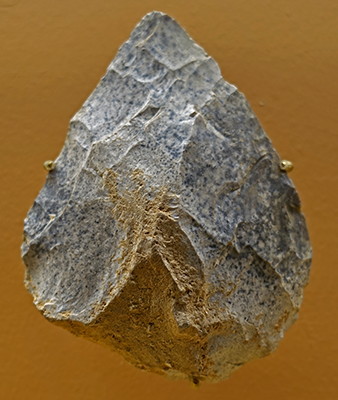
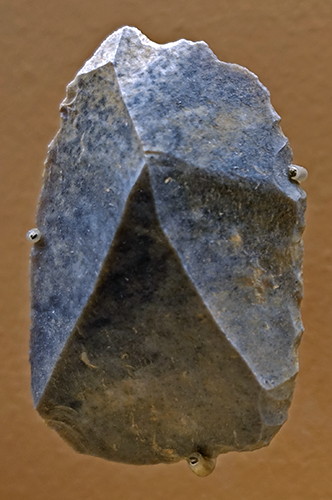
(left): Mousterian biface.
(right): Retouched flake.
From the D, C, A Mousterian layers of La Ferrassie.
Photo: Don Hitchcock 2018
Source: Original, Musée d'Archeologie Nationale et Domaine, St-Germain-en-Laye
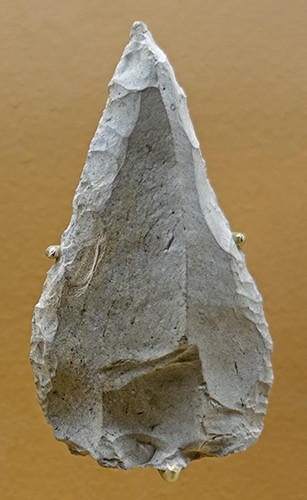
Mousterian point.
From the D, C, A Mousterian layers of La Ferrassie.
Photo: Don Hitchcock 2018
Source: Original, Musée d'Archeologie Nationale et Domaine, St-Germain-en-Laye

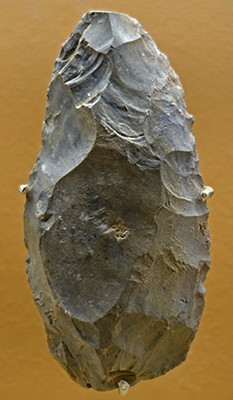
Racloirs, side scrapers.
( Racloirs or side scrapers are typical of the Mousterian tradition. Grattoirs or end scrapers came with the Aurignacian and the Cro-Magnons - Don )
From the D, C, A Mousterian layers of La Ferrassie.
Photo: Don Hitchcock 2015, 2018
Source: Original, Musée d'Archeologie Nationale et Domaine, St-Germain-en-Laye
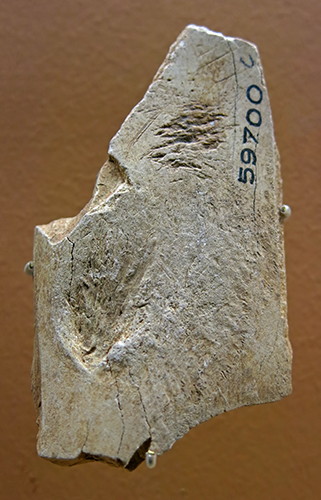
Retoucher, in bone.
( Retouchers are an essential part of every knapper's toolkit. They are used for tapping flakes off a larger piece of flint to reshape, sharpen and dull a tool as necessary - Don )
From the D, C, A Mousterian layers of La Ferrassie.
Photo: Don Hitchcock 2015, 2018
Source: Original, Musée d'Archeologie Nationale et Domaine, St-Germain-en-Laye
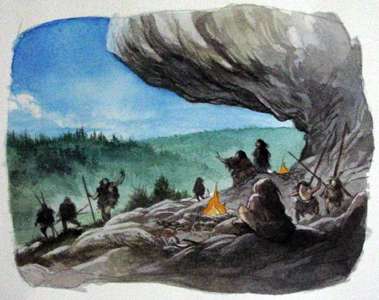
The assemblage of burials of La Ferrassie, about 50 000 BP
The site of La Ferrassie is one of two deposits in the world to have broadly contemporary multiple burials. The subjects belong to different age groups, and thus give a good picture of the population.
Their number - 7 people - is a measure of the size Neanderthal groups approached at the time. These highly structured groups were able to take care of older and frailer individuals who did not contribute directly to the material life of the group.
These individual burials, were intended to protect the body after death. This behaviour reflects a true humanity.
Text: Adapted and translated from the display at Musée National de Préhistoire, Les Eyzies
Photo: Don Hitchcock 2008
Artist:© Emmanuel Roudier, 2008
Superb watercolours were done for this exhibition by the French artist, Emmanuel Roudier.
Blog: http://roudier-neandertal.blogspot.com/ Contact: emmanuelroudier@gmail.com
Source: Display at Musée National de Préhistoire, Les Eyzies
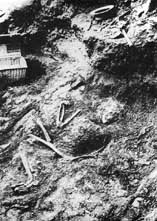
Note the straw boater, pickaxe and picnic basket, symbols of a bygone age.
La Ferrassie produced the remains of an adult male and an adult female, providing documentation of sexual dimorphism (differences in size between males and females) in Neanderthals. In addition, the remains of the juvenile and infant individuals help paleoanthropologists reconstruct the developmental stages of Homo neanderthalensis.
An important result is that the morphology of the leg bones and the foot demonstrate without any doubt that the posture and gait of Neanderthals differed very little from modern humans. Today the skeleton of La Ferrassie 1 is considered the "classic" example of Neanderthal anatomy.
Recent dating of the La Ferrassie shelter indicates that the skeletons may be as old as 70 000 years.
Photo: Secrets of the Ice Age by Evan Hadingham, 1980
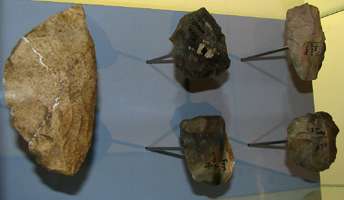
Industrie lithique associée aux sépultures de La Ferrassie, fouille D. Peyrony. Collection de Musée National de Préhistoire des Eyzies
Stone tools found with the graves of La Ferrassie, excavated by D. Peyrony. Collection Musée National de Préhistoire des Eyzies
Text: adapted and translated from the display at Musée National de Préhistoire, Les Eyzies
Photo: Don Hitchcock 2008
Source: Originals, display at Musée National de Préhistoire, Les Eyzies
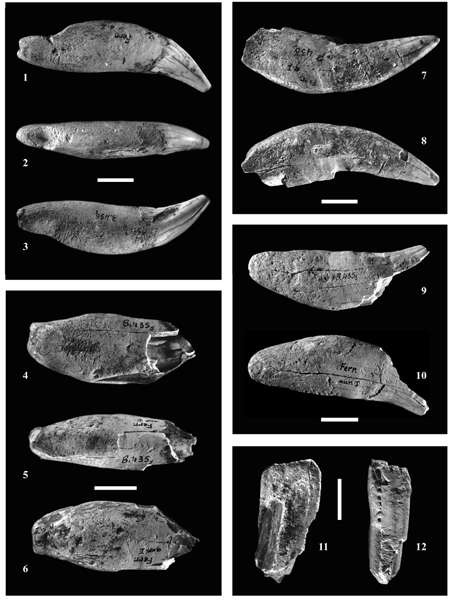
La Ferrassie, Aurignacian I : teeth used as retouchers, large carnivores canines and horse molar (Photos P. Jugie, MNP).
1 to 3: B.435.3, Panthera spelaea, lower right canine, dimensions: 103.9 x 27.3 mm; 1: inner view, 2: anterior view, 3: exterior view. 4 to 6: B.435.5, probable Panthera spelaea, upper right or left canine, 73.4 x 30.8 mm; 4: external or internal view, 5: anterior or posterior view, 6: internal or exterior view. 7 and 8: B.435.1, Panthera spelaea, upper left canine, 106.5 x 31.0 mm; 7: exterior view, 8: interior view. 9 and 10: B.435.2, Panthera spelaea, upper left canine, 98.7 x 31.5 mm; 9: exterior view, 10: interior view. 11: Equus caballus, upper molar, right 1 or 2, mesial view: 60.8 x 28.7 mm, size of mesial side: 44 x 23 mm. 12: Equus caballus, lower premolar, left 3 or 4, mesial view: 60.8 x 31 mm, size of mesial side: 51.5 x 16.5 mm.
Photo and text: http://paleo.revues.org/index1212.html

Aurignacian double edged Scraper on blade - 3 views of the same object, from the Aurignac type site, Haute-Garronne, France.
Date: between 45 000 and 35 000 BP
medium: flint
Dimensions: 74 × 29 × 12 mm
Source: Muséum de Toulouse
Accession number: MHNT.PRE.2010.0.91.1
Findspot: Aurignac, Haute-Garonne, France – Former collection of Édouard Lartet and Louis Lartet 1862.
Photo: Didier Descouens, 12 June 2011
Permission: licensed under the Creative Commons Attribution-Share Alike 3.0 Unported license.
IMG_5739ferrassiebone IMG_5740ferrassiebone IMG_5741ferrassiebone Les blocs Aurignaciens
Les blocs aurignaciens ont tous été découverts dans une zone circonscrite à une dizaine de kilomètres autour des Eyzies. Outre quelque signes, les thèmes iconographiques, gravés par piquetage pour la plupart, sont de deux types: silhouettes animales difficilement déterminables et représentations sexuelles féminines. Leur datation couvre l'ensemble de la période aurignacienne (plus de cing millénaires), quelques rares exemplaires débordant sur le Périgordien. A la même époque, d'importantes variations régionales apparaissent: en Ardèche par exemple. (Grotte Chauvet-Pont d'Arc), gravures et dessins ont été réalisés en grotte profonde.
Aurignacian (Upper Paleolithic culture between Mousterian and Solutrean, Cro-Magnon man) blocks have been discovered in an area limited to ten kilometres radius from Les Eyzies. In addition to some iconographic signs, engraved by pecking for the most part, there are two types: easily recognised animal silhouettes and female sexual representations. Dating covers the Aurignacian period (more than five millennia), with a few rare examples stretching into the Périgordien. At the same time, significant regional variations appear: for example in the Ardèche, at Chauvet Cave, engravings and drawings were made deep in a cave.
Text above from the display at Musée National de Préhistoire, Les Eyzies
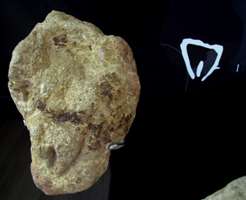
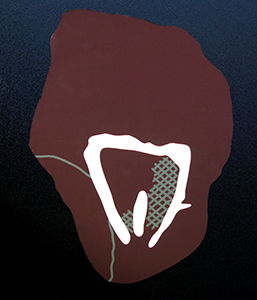
La Ferrassie, Aurignacian sculpture of a vulva.
Photo: Don Hitchcock 2008, 2014
Source: Original, display at Musée National de Préhistoire, Les Eyzies
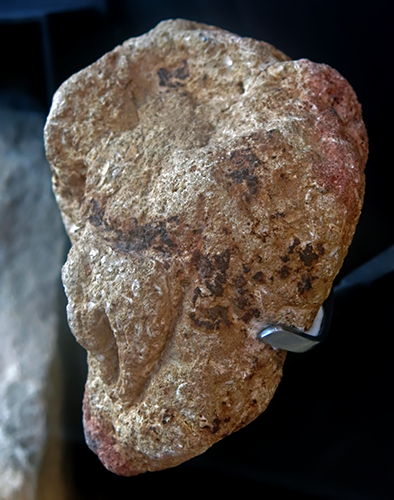
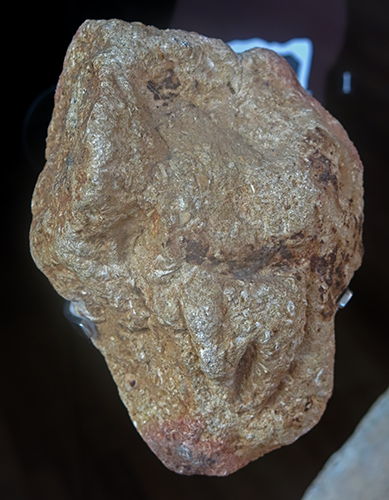
High definition images of an Aurignacian sculpture of a vulva from La Ferrassie.
This is much more of a sculpture than an engraving, with a pronounced three dimensional aspect to the piece, obvious especially in the image on the left.
Photo: Don Hitchcock 2014
Source: Original, display at Musée National de Préhistoire, Les Eyzies
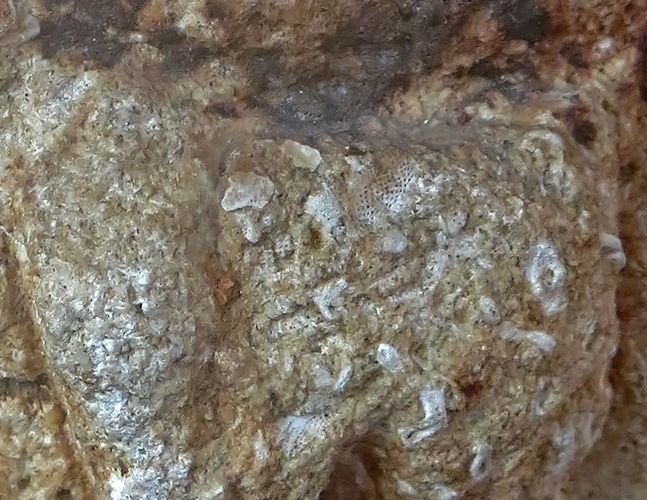
The vulva sculpture above has been carved from a limestone breccia, which may be seen when the thumbnail on the right above (in particular) is clicked to see the full size image.
In the close up at left, we may see pieces of shell and coral (the net-like pattern) embedded in the matrix.
Photo: Don Hitchcock 2014
Source: Original, display at Musée National de Préhistoire, Les Eyzies
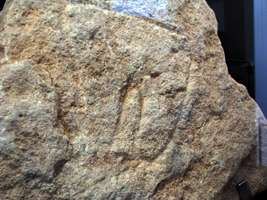
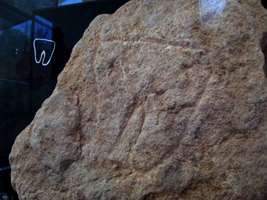
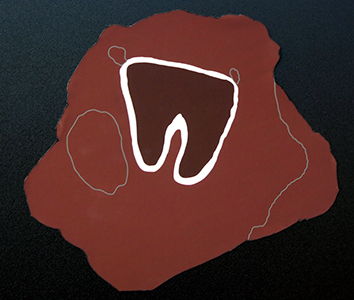
La Ferrassie, Aurignacian engraving of a vulva.
Photo: Don Hitchcock 2008, 2014
Source: Original, display at Musée National de Préhistoire, Les Eyzies
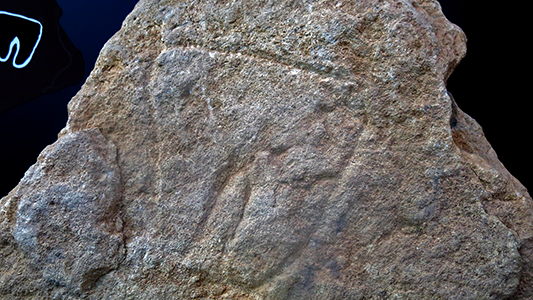
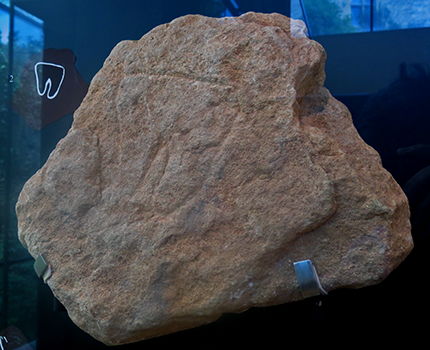
La Ferrassie, Aurignacian engraving of a vulva.
Photo: Don Hitchcock 2014
Source: Original, display at Musée National de Préhistoire, Les Eyzies
La Ferrassie, high definition images of an Aurignacian engraving of a vulva.
Catalog: MNP34.1.08
Photo: Don Hitchcock 2014
Source: Original, display at Musée National de Préhistoire, Les Eyzies
La Ferrassie, Aurignacian engravings of vulvas and cupules.
Photo: Don Hitchcock 2008, 2014
Source: Original, display at Musée National de Préhistoire, Les Eyzies
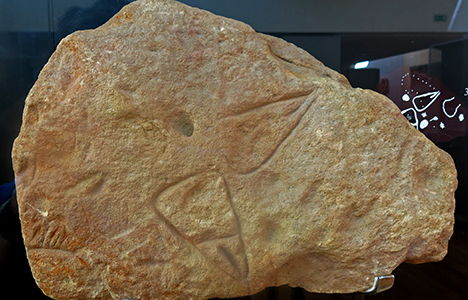
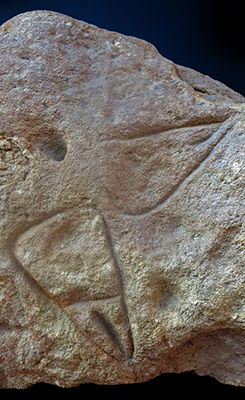
La Ferrassie, high definition images of Aurignacian engravings of vulvas and cupules.
Catalog: MNP34.1.07
Photo: Don Hitchcock 2014
Source: Original, display at Musée National de Préhistoire, Les Eyzies

Engraved rock, with the legs of a four footed animal, as well as the outline of a vulva, and many cupules, from Ferrassie.
Photo: Don Hitchcock 2014
Source: Original, display at Musée National de Préhistoire, Les Eyzies
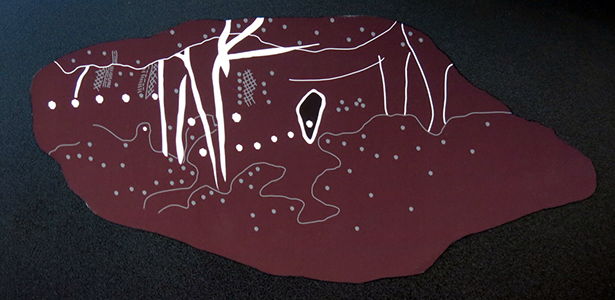
Drawing of the engraved rock above.
Photo: Don Hitchcock 2014
Source: Display at Musée National de Préhistoire, Les Eyzies
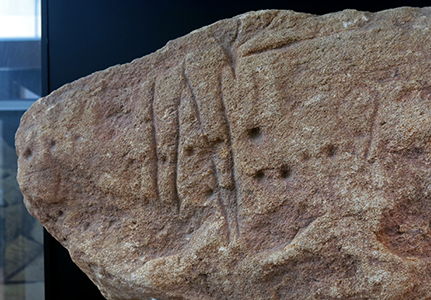
It would seem that the cupules and the vulva have been engraved first, with the legs of the quadruped being added later.
The rock may have originally held the complete outline of an animal, and was subsequently broken in half from side to side.
The vulva and the cupules to the right of it seem very old and faint.
Photo: Don Hitchcock 2014
Source: Display at Musée National de Préhistoire, Les Eyzies

The engraved clast No. 16 from La Ferrassie, Middle
Aurignacian, with the main cupules and the presumed vulva
symbol emphasised.
Photo and text: Rock Art Research 2008 - Volume 25, Number 1, pp. 61-100 R. G. BEDNARIK
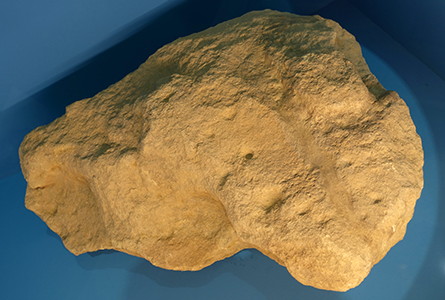
Stone with cupules from La Ferrassie.
Photo: Don Hitchcock 2018
Collections du Muséum national de Préhistoire, Les Eyzies-de-Tayac
Source and text: Musée de l'Homme, Paris
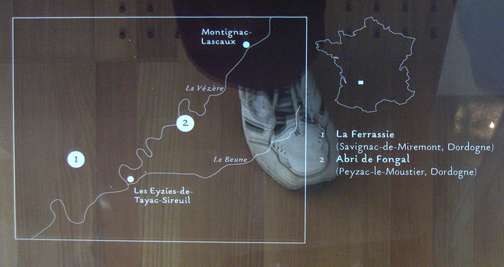
Map showing the position of l'Abri de Fongal and La Ferrassie.
Photo: Don Hitchcock 2008
Source: Display at Musée National de Préhistoire, Les Eyzies
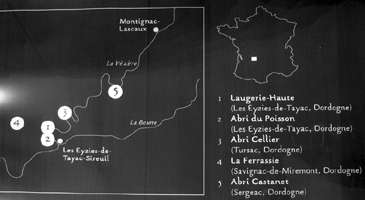
Map showing the position of La Ferrassie and other significant sites with Aurignacian blocks.
Photo: Don Hitchcock 2008
Source: Display at Musée National de Préhistoire, Les Eyzies
Rock with cupules from La Ferrassie, possibly Aurignacian.
Photo: Don Hitchcock 2014
Source: Original, display at Musée National de Préhistoire, Les Eyzies

In the same case as the rock with cupules from La Ferrassie were these two others from l'Abri Fongal, dated as Aurignacian/Perigordian.
Photo: Don Hitchcock 2008
Source: Original, display at Musée National de Préhistoire, Les Eyzies
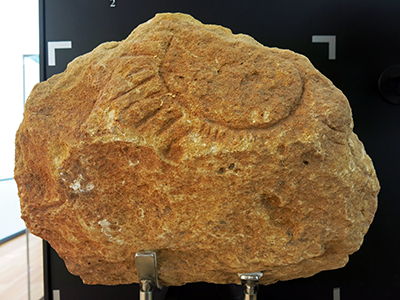
This engraving from l'Abri Fongal reminds me irresistibly of the sun.
Photo: Don Hitchcock 2014
Source: Original, display at Musée National de Préhistoire, Les Eyzies
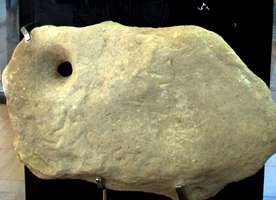
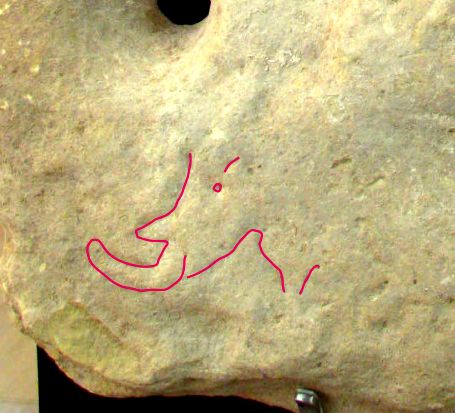
This "Pierre à Anneau" from l'Abri de Fongal has an engraving of a rhinoceros.
(See my web page on Castel-Merle for a fuller description of 'Pierres à Anneaux'. They may have been to hold cords from the roof of abris to support hide curtains, and fallen ones would have been ideal for securing the base of the hide shelters, which provided protection from wind, rain and snow. )
Photo: Don Hitchcock 2008, as well as the outlining of the rhinoceros.
Source: Original, display at Musée National de Préhistoire, Les Eyzies
c
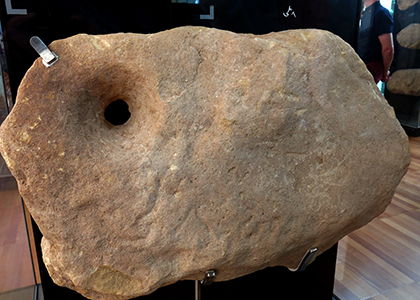
This Pierre à Anneau appears to have been pierced after falling from the roof, and to have been decorated at that time.
Photo: Don Hitchcock 2014
Source: Original, display at Musée National de Préhistoire, Les Eyzies
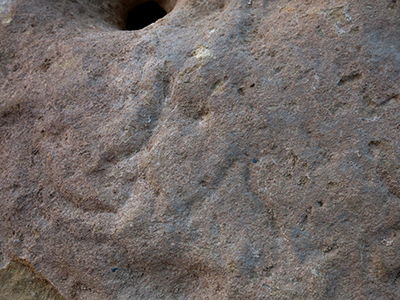
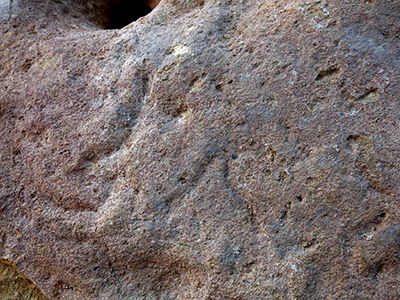
Closeups of the Pierre à Anneau rhino engraving from l'abri Fongal.
Photo: Don Hitchcock 2014
Source: Original, display at Musée National de Préhistoire, Les Eyzies
 Text and photo adapted from the Smithsonian site:
Text and photo adapted from the Smithsonian site:
http://www.mnh.si.edu/anthro/humanorigins/ha/laferr.html
La Ferrassie rock shelter is located near the village of Les Eyzies in the Dordogne valley, France.The site yielded skeletons from eight Neanderthal individuals, including adults, children, infants, and two fetuses. All were intentionally buried at the shelter. It was discovered on 17th September 1909 by R. Capitan and D. Peyrony.
La Ferrassie 1 skeleton had all of the teeth preserved in place and show heavy wear indicating that the individual was relatively old at the time of his death. It has been hypothesized that the bevelling of the biting surface of the incisor teeth towards the lip was the result of habitual use of the teeth for purposes other than chewing, such as holding something in place between the teeth. Although the interpretation has been debated, the use of the teeth as a tool may represent an interesting aspect of Neanderthal culture.
Ferrassie 1
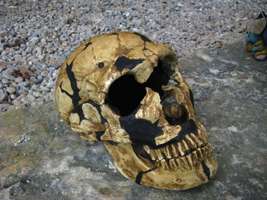

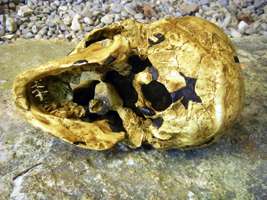
Skull of the old man of La Ferrassie
Photo: Don Hitchcock 2008
Source: facsimile used by the tour guide at La Ferrassie.
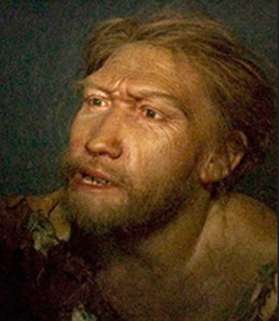
Recreation of La Ferrassie 1 by Elizabeth Daynès.
From: http://www.daynes.com/en/reconstructions/neander.php
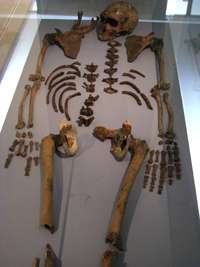
La Ferrassie 1 skeleton
Le premier des 7 individus exhumés à partir de 1909, est un sujet adulte bien fossilisé, reposant peut-être dans une dépresion naturelle en position semi-fléchie sur le dos. Les conditions de fouille, loin d'être idéales, limitent nos connaissances sur le mode d'inhumation.
L'étude anthropologique montre en revanche un individu "âgé" (une quarantine d'années) très diminué physiquement, qui devait être pris en charge par le groupe, attestant, dès l'époque néandertalienne, une première structuration sociale.
Photo: Don Hitchcock 2008
Text: From the display at Musée National de Préhistoire, Les Eyzies
Source: Original, display at Musée National de Préhistoire, Les Eyzies
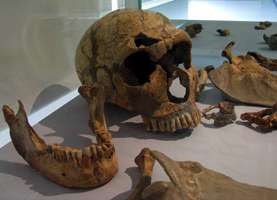
The first of 7 individuals exhumed from 1909, is a well-fossilized adult, lying perhaps in a natural depression in a semi-flexed position on his back. The methods of excavation were far from ideal, giving us limited knowledge about the method of burial.
The anthropological study shows however an "old" individual (about forty years old) physically diminished, possibly looked after by the group, indicating, even from the time of the Neanderthals, a strong social structure.
Photo: Don Hitchcock 2008
Text: adapted and translated from the display at Musée National de Préhistoire, Les Eyzies
Source: Original, display at Musée National de Préhistoire, Les Eyzies
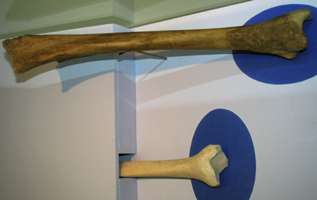
Moulage des tibias de La Ferrassie 1:
réaction osseuse traduisant une infection pulmonaire et sanguine.
Casts of the tibias of La Ferrassie 1:
The result on the bones of lung and blood infections.
Photo: Don Hitchcock 2008
Text: adapted and translated from the display at Musée National de Préhistoire, Les Eyzies
Source: Facsimiles, display at Musée National de Préhistoire, Les Eyzies
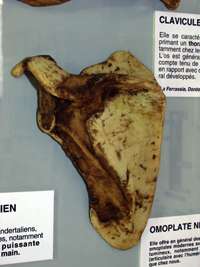
Neandertal shoulder blade (omoplate, scapula), possibly from the Ferrassie I skeleton.
Photo: Don Hitchcock 2008
Source: Facsimile, display at Neandertal Museum, la Chapelle-aux-Saints

Facsimile of the left clavicle of "La Ferrassie, Dordogne", presumably of Ferrassie 1. It is good to get a close up of this important bone, even in facsimile, since it was obscured in the display at Musée National de Préhistoire, Les Eyzies
Clavicule Néandertalienne
Elle se caractérise par une grande longeur exprimant un thorax large et une forte carrure, notamment chez les hommes.
L'os est généralement aplati, relativement gracile compte tenu de sa longeur, et fortement recourbé en rapport avec des muscles trapèze et grand pectoral développés.
(La Ferrassie, Dordogne, clavicule gauche)
Neanderthal Clavicle
It is characterized by great length expressing a broad chest and strong build, especially among men.
The bone is generally flat, relatively gracile given its length, and strongly curved pointing to well developed pectoralis major (pecs) muscles.
(La Ferrassie, Dordogne, left clavicle)
Photo: Don Hitchcock 2008
Source: Facsimile, display at Neandertal Museum, la Chapelle-aux-Saints. The text is derived from this source, and I have translated the French, with additional information from Wikipedia.

Le Radius Néandertalien
Il est caractérisé par la forte courbure de la diaphyse, déjà présente chez le tout jeune enfant. Chez l'adulte, elle augmente la surface de la membrane interosseuse sur laquelle s'insèrent les muscles de l'avant-bras.
D'autre par, le col radial est allongé, ce qui a pour effet d'éloigner du coude la tubérosité bicipitale: pour produire un même travail mécanique, le triceps et le biceps pouvaient être plus faibles, d'où une économie musculaire.
Neanderthal Radius
The radius is characterised by the strong curvature of the shaft, already present in the young child. In adults, it increases the interosseous membrane of the forearm, which is a fibrous sheet that connects the radius and the ulna. It is the main part of the radio-ulnar syndesmosis, a fibrous joint between the two bones.
As well, the neck of the radius is stretched, which has the effect of moving the elbow away from the radial tuberosity. Thus, to produce the same mechanical work, the triceps and biceps can be lower, resulting in a saving of muscle power for the same work.
Beneath the neck of the radius, on the medial side, is an eminence, the radial tuberosity; its surface is divided into:
* a posterior, rough portion, for the insertion of the tendon of the biceps brachii.
* an anterior, smooth portion, on which a bursa is interposed between the tendon and the bone.
Photo: Don Hitchcock 2008
Source: Facsimile of the right radius and ulna of "La Ferrassie", presumably La Ferrassie 1, display at Neandertal Museum, la Chapelle-aux-Saints. The text is derived from this source, and I have translated the French, with additional information from Wikipedia.

Humérus Néandertalien
(La Ferrassie, Humérus droit)
Comme sur tous les os longs des Néandertaliens, les épiphyses sont très volumineuses, notamment l'extremité distale qui dénote une puissante musculature pour l'avant-bras et la main.
Neanderthal Humerus
(La Ferrassie, right Humerus)
as in all long bones of Neanderthals, the epiphyses are very large, including the distal tip, indicating powerful muscles in the forearm and hand.
Photo: Don Hitchcock 2008
Source: Facsimile of the humerus of "La Ferrassie", presumably La Ferrassie I, display at Neandertal Museum, la Chapelle-aux-Saints. The text is derived from this source, and I have translated the French, with additional information from Wikipedia.
Ferrassie 2

Découverte du squelette de La Ferrassie 2.
Il se trouvait à l'emplacement recouvert d'un drap blanc.
(Cliché MNP, fond D.Peyrony)
Discovery of the La Ferrassie 2 skeleton, found at the place covered by a white cloth in the foreground at the bottom of the photo.
Photo: Original photo by MNP, dig by D. Peyrony.
Rephotography: Don Hitchcock, 2008, from the display at Musée National de Préhistoire, Les Eyzies
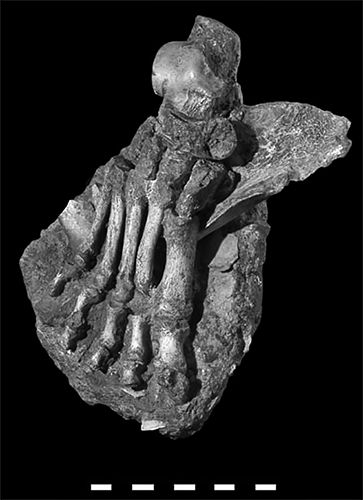
Foot of the skeleton of La Ferrassie 2 still conserved in its block of sediment.
Photo: Musée de l’Homme via Turq et al. (2012)
Source: Musée de l’Homme
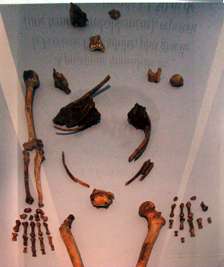
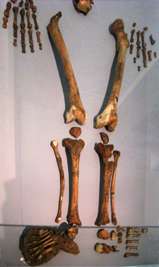
A proximité immédiate de La Ferrassie 1, cet adulte, plus gracile (une femme probablement), reposait en position contractée à 1,50 m de la paroi de l'abri.
Après les travaux sur le terrain de 1910, le dégagement du fossile est effectué à Paris en laboratoire. Les informations sur le contexte (fosse, situation) restent très limitées.
Near Ferrassie 1, this adult, more gracile than Ferrassie 1 (probably a woman), lay in a curled up position 1.50 meters from the wall of the shelter.
After the field work of 1910, the fossil was cleaned in the Paris laboratory. Information on the context of the discovery remains very limited.
Photo: Don Hitchcock 2008. Note that the second pair of photographs have been stretched to try to remove some of the distortions inherent in photographing a long horizontal display case from a low height.
Text: adapted and translated from the display at Musée National de Préhistoire, Les Eyzies
Source: Original, display at Musée National de Préhistoire, Les Eyzies
Ferrassie 3
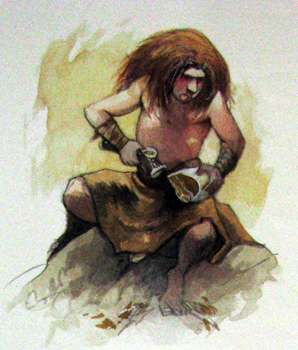 L'enfant de la Ferrassie 3, âgé de 5 à 7 ans, a été inhumé dans une fosse hémisphérique aux bords évasés de 70 x 40 x 60 cm environ. Ses restes osseux sont étrangement conservés" certains éléments fragiles ont résisté, d'autres beaucoup plus solides disparu...
L'enfant de la Ferrassie 3, âgé de 5 à 7 ans, a été inhumé dans une fosse hémisphérique aux bords évasés de 70 x 40 x 60 cm environ. Ses restes osseux sont étrangement conservés" certains éléments fragiles ont résisté, d'autres beaucoup plus solides disparu...
Cette situation, qui n'est pas imputable à la fouille rappelle le cas de Saint-Césaire: une possible intervention sur un dépôt primaire qui permet d'effluer la complexité des gestes funéraires néandertaliens...
Text: From the display at Musée National de Préhistoire, Les Eyzies
Photo: Don Hitchcock 2008
Artist:© Emmanuel Roudier, 2008
Superb watercolours were done for this exhibition by the French artist, Emmanuel Roudier.
Blog: http://roudier-neandertal.blogspot.com/ Contact: emmanuelroudier@gmail.com
Source: Display at Musée National de Préhistoire, Les Eyzies
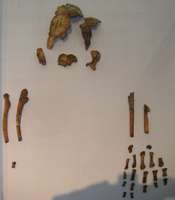
The Ferrassie 3 child, aged between five and seven years old, was buried in a hemispherical pit flared at the edges, with diimensions of 70 x 40 x 60 cm. His skeletal remains have been strangely preserved - some fragile parts have survived, other much more solid parts have disappeared.
This situation, which is not due to problems in the excavation, recalls the case of Saint-Césaire: a possible later intervention with the first burial, which would indicate further complexity in the funeral ceremonies of the Neanderthals.
Photo: Don Hitchcock 2008
Text: adapted and translated from the display at Musée National de Préhistoire, Les Eyzies
Source: Original, display at Musée National de Préhistoire, Les Eyzies
Ferrassie 5
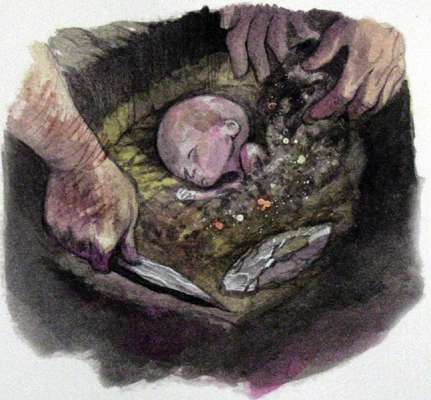
Ces quelques éléments fragmentaires du crâne et des os longs appartiennent à un foetus de 7 mois inhumé dans une dépression ovalaire peu profonde et recouverte d'un monticule de terre.
Plusieurs beaux racloirs de silex semblent avoir été déposés à proximité. C'est à ce jour le seul cas connu d'inhumation volontaire d'un sujet mort avant terme, pour tout le Paléolithique.
Text: From the display at Musée National de Préhistoire, Les Eyzies
Photo: Don Hitchcock 2008
Artist:© Emmanuel Roudier, 2008
Superb watercolours were done for this exhibition by the French artist, Emmanuel Roudier.
Blog: http://roudier-neandertal.blogspot.com/ Contact: emmanuelroudier@gmail.com
Source: Display at Musée National de Préhistoire, Les Eyzies

These few fragments of a skull and some bones belong to a foetus of seven months buried in a shallow oval depression and covered with a mound of earth.
Several beautiful flint scrapers were found nearby. It is so far the only known case of the deliberate burial of a premature baby in the whole of the Palaeolithic.
Photo: Don Hitchcock 2008
Text: adapted and translated from the display at Musée National de Préhistoire, Les Eyzies
Source: Original, display at Musée National de Préhistoire, Les Eyzies
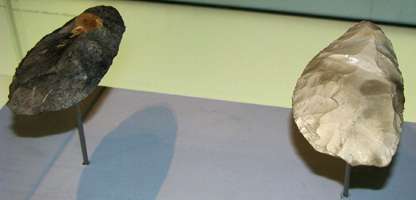
Deux des trois racloirs trouvés à proximité du squelette de La Ferrassie 5, fouille D. Peyrony.
(collection du Musée national de Préhistoire des Eyzies)
Two of the three scrapers found near the skeleton La Ferrassie 5, excavation by D. Peyrony.
Photo: Don Hitchcock 2008
Text: adapted and translated from the display at Musée National de Préhistoire, Les Eyzies
Source: Original, display at Musée National de Préhistoire, Les Eyzies
Ferrassie 6
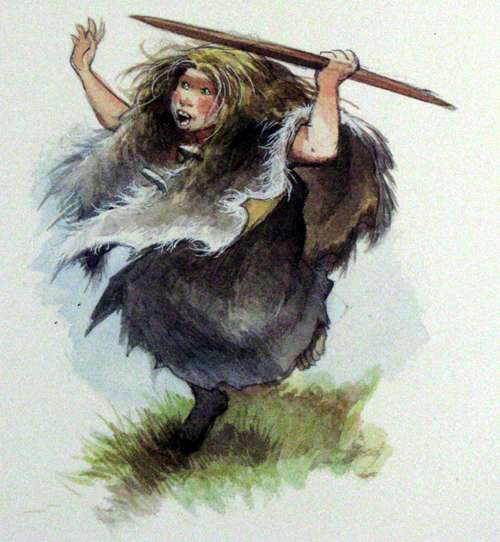
Cet enfant de 3 ans, l'un des mieux conservés pour cette classe de l'âge, était inhumé, membres inférieurs fléchis, dans une fosse trapézoïdale creusée dans le sol naturel. Le squelette était en connexion, à l'exception du crâne, apparemment séparé et retrouvé à peu de distance. L'ensemble était surmonté d'un bloc calcaire triangulaire portant une série de cupules.
Les << beaux instruments de silex >> (des offrandes?) qui accompagnaient le corps ont malheuresement disparu.
Text: From the display at Musée National de Préhistoire, Les Eyzies
Photo: Don Hitchcock 2008
Artist:© Emmanuel Roudier, 2008
Superb watercolours were done for this exhibition by the French artist, Emmanuel Roudier.
Blog: http://roudier-neandertal.blogspot.com/ Contact: emmanuelroudier@gmail.com
Source: Display at Musée National de Préhistoire, Les Eyzies

This three year old child, one of the best preserved for this age group was buried, lower limbs bent, in a trapezoidal pit dug into the soil. The skeleton was complete and undisturbed with the exception of the skull, apparently separated, but recovered a short distance away.
Photo: Don Hitchcock 2008
Text: adapted and translated from the display at Musée National de Préhistoire, Les Eyzies
Source: Original, display at Musée National de Préhistoire, Les Eyzies
The burial was covered by a triangular limestone block with a series of cupules.
The "beautiful flint tools" (offerings?) which originally accompanied the body have unfortunately disappeared.
Photo: Don Hitchcock 2008
Text: adapted and translated from the display at Musée National de Préhistoire, Les Eyzies
Source: Original, display at Musée National de Préhistoire, Les Eyzies
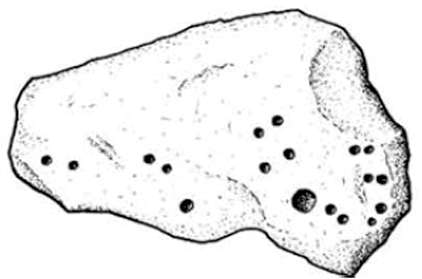
The oldest cupules known in Europe are also the oldest rock art we
have found in that continent. Neanderthal burial No. 6 of the French cave
La Ferrassie is of a child. After the corpse was placed in the grave, a
large limestone slab was deposited over it in such a way that the 18
cupules on its surface came to be on its underside, i.e. were facing the
child’s corpse (Peyrony 1934: 34). This burial is part of a Mousterian
graveyard of unknown age, but is in all probability between 70 000 and
perhaps 40 000 years old. It is particularly interesting that 16 of the
cupules are clearly arranged in pairs. The entire find suggests great
cultural complexity.
Photo and text: Cupules — the oldest surviving rock art Robert G. Bednarik 2001 mc2.vicnet.net.au/home/cognit/shared_files/cupules.pdf
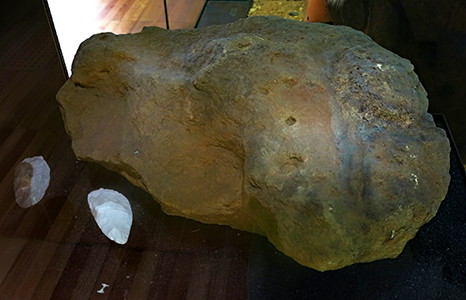
In 2014, the rock was accompanied by two racloirs (side scrapers), distinctive Mousterian tools, found near the burial of La Ferrassie 5, as above.
Photo: Don Hitchcock 2014
Source: Original, display at Musée National de Préhistoire, Les Eyzies
Ferrassie 8
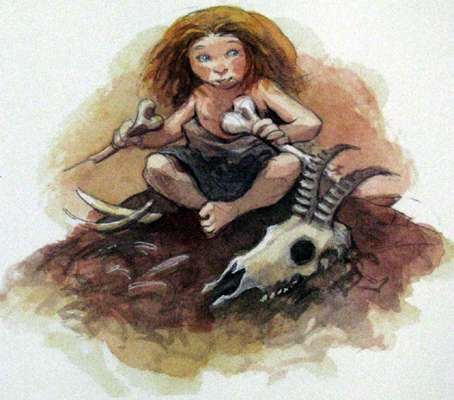
Les fragments sur l'un de l'enfant de la Ferrassie 8 (en fait le 7e individu découvert sur le site) sont identifiés en plusieurs temps comme provenant d'une zone circulaire proche du fond de l'abri.
Les mauvaises conditions de fossilisation ajoutées à celles de fouilles difficiles ne livrent malheureusement pas toutes les informations que l'on était en droit d'espérer de travaux (Delporte, 1973).
La conservation différentielle des éléments du squelette peut, néanmoins, vraisemblablement, être imputée à des causes naturelles.
Text: From the display at Musée National de Préhistoire, Les Eyzies
Photo: Don Hitchcock 2008
Artist:© Emmanuel Roudier, 2008
Superb watercolours were done for this exhibition by the French artist, Emmanuel Roudier.
Blog: http://roudier-neandertal.blogspot.com/ Contact: emmanuelroudier@gmail.com
Source: Display at Musée National de Préhistoire, Les Eyzies
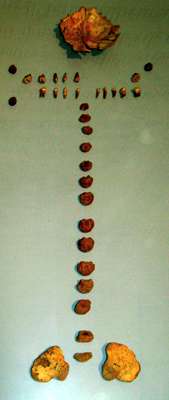
Fragments of the child known as Ferrassie 8 (actually the 7th individual discovered at the site) were identified over several days from a circular area near the bottom of the shelter.
The poor conditions for fossilisation added to the difficulties of excavation unfortunately means that all the information one might expect was not recovered from the work by Delporte, in 1973.
The differences of quality of preservation may, however, be attributed to natural causes.
Photo: Don Hitchcock 2008
Text: adapted and translated from the display at Musée National de Préhistoire, Les Eyzies
Source: Original, display at Musée National de Préhistoire, Les Eyzies
Historical Documents
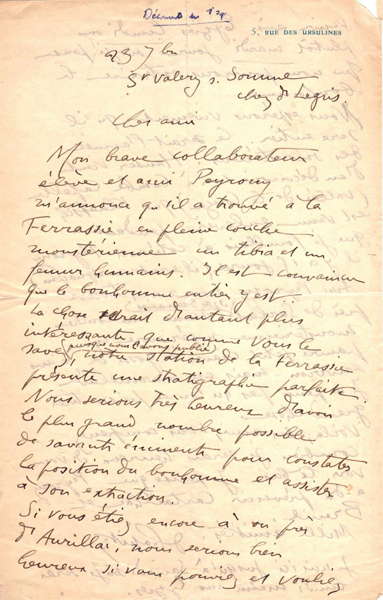

Letter from Louis Capitan written 23rd September 1909 to Marcellin Boule, director of the Laboratory of Paleontology at the National Museum of Natural History announcing Denis Peyrony's discovery of the La Ferrasie 1 skeleton.
Photo: http://albuga.free.fr/en/prehistoire/heim/article.html
My sincere thanks to Daniela Hager who very kindly transcribed the letter for me.
Transcription:
Letter from Louis Capitan to Marcellin Boule, Director of the Laboratoire de Paléontologie au Muséum National d’Histoire Naturelle, announcing Denis Peyrony’s discovery of the La Ferrasie 1 skeleton. L. Capitan invites M. Boule to Les Eyzies so he would be present to confirm the stratigraphic position and assist during the recovery of the skeleton on September 27, 1909 (written 23/09/1909).
http://albuga.free.fr/en/prehistoire/heim/article.html
5, RUE DES URSULINES
…. St Valery s. Somme
chez Dr. Legris.
Cher ami
Mon brave collaborateur élève et ami Peyrony m'annonce qu'il a trouvé à la Ferrassie en pleine couche moustérienne un tibia et un fémur humain. Il est convaincu que le bonhomme entier y est. La chose serait d'autant plus intéressante que, comme vous le savez, puisque nous l'avons publié, notre station de la Ferrassie présente une stratigraphie parfaite.
Nous serions très heureux d'avoir le plus grand nombre possible de savants éminents pour constater la position du bonhomme et assister à son extraction.
Si vous étiez encore à ou près d'Aurillac, nous serions bien heureux si vous pouviez et vouliez venir aux Eyzies lundi ou plutôt mardi jour où je pense que nous pourrons extraire le bonhomme.
Nous espérons vivement qu'il sera entier. Ce serait l'année des moustériens. Hauser vient d'en découvrir un à Combe Capelle (vallée de la Couze) que Klaatsch est venu enlever pendant que je fouillais à coté avec Peyrony il y a 19? jours (il serait aurignacien).
Avec Peyrony nous avons trouvé près de Sarlat il y a 3 semaines dans une couche moustérienne supérieure un pauvre petit crâne de gosse de 6 ans environ – mais en marmelade. Je ne pense pas qu'on en puisse tirer grand‐chose.
Voilà, cher ami; vous comprenez combien je serais heureux de vous voir là‐bas. Je pense que Peyrony a dû prévenir Cartailhac et Breuil.
Mille amitiés.
D. Capitan
Je suis ici jusqu'à Samedi soir. Je serai lundi matin aux Eyzies.
Translation of the letter by Don Hitchcock:
5, Rue des Ursulines
St Valery sur Somme (on the English Channel, north of Paris )
at the home of Dr. Legris.
Dear friend
My good friend, student, and collaborator Peyrony told me that he found in the middle of the Mousterian layer at la Ferrassie a human tibia and femur. He is convinced that the rest of the skeleton is there. The whole thing is even more interesting since as you know (because we have published our paper) the station at Ferrassie has preserved a perfect stratigraphy.
We would like to have the greatest possible number of eminent scientists to see the position of the skeleton and attend its extraction.
If you were still at or near Aurillac, (about 110 km due east of les Eyzies ) we would be delighted if you could come to les Eyzies, (if you wish to). Monday might be better than Tuesday, when I think we will extract the skeleton.
We sincerely hope that the skeleton will be complete. This must be the year of the Mousterian!
Hauser (Otto Hauser, German archaeologist ) has just discovered one at Combe Capelle (in the Couze Valley) which Klaatsch helped him to excavate, where I was digging beside Peyrony just 19(?) days ago (it was Aurignacian in age).
Near Sarlat 3 weeks ago Peyrony and I found, in an upper Mousterian layer, the skull of a poor little kid about 6 years old - but it was badly damaged. I do not think we can learn much.
(The child's skull was found by Peyrony and Capitan in 1909 in the cave of Pech de l'Aze, near Sarlat, Dordogne )
So, dear friend, I hope you understand how happy I would be to see you there. I think Peyrony has also made Cartailhac and Breuil aware of the find.
Kindest regards.
D. Capitan
I'm here until Saturday evening. On Monday morning I'll be at Les Eyzies.
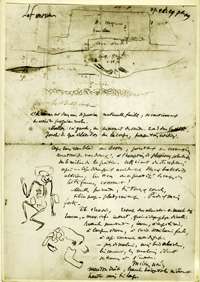
Abbé Henri Breuil's handwritten note and sketch describing the sepulchre of the La Ferrassie Man (Le Musée de l'Homme archives, Paris).
Photo: http://albuga.free.fr/en/prehistoire/heim/main.html
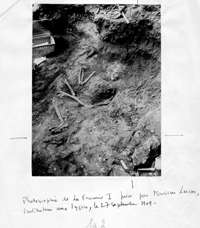
Photographie de La Ferrassie I prise par Monsieur Lucas, l'institution aux Eyzies, le 27 Septembre 1909
Photograph of La Ferrassie I taken by Monsieur Lucas, l'institution aux Eyzies, 27 September 1909.
Photo: http://albuga.free.fr/en/prehistoire/heim/main.html

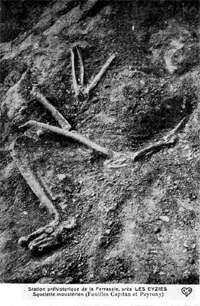
Postcard sent to Marcellin Boule by Denis Peyrony on January 5, 1918 to announce that work was to be resumed at Les Eyzies
Photo: http://albuga.free.fr/en/prehistoire/heim/main.html
References
- Camps-Fabrer, H. et al., 1998: Biseaux et Tranchants, Fiches Typologiques de l'Industrie osseuse préhistorique, Cahier VIII, Éditions du Cedarc Treignes
- Capitan, L. and Peyrony, D., 1910: Deux squelettes humains au milieu de foyers de l'époque moustérienne Bulletins et Mémoires de la Société d'anthropologie de Paris, Année 1910, Volume 1, Numéro 1 p. 48 - 56
- Cheynier, A., 1960: Place pour le Gravétien Bulletin de la Société préhistorique française, 1960, tome 57, N. 7-8. Travaux en retard. pp. 389-412.
- Cook, J., 2013: Ice Age art: arrival of the modern mind, The British Museum, 18 Feb 2013, ISBN-10: 0714123331, ISBN-13: 978-0714123332
- Delluc, G.&B., 1978: Les manifestations graphiques aurignaciennes sur support rocheux des environs des Eyzies (Dordogne), Gallia préhistoire, Tome 21 fascicule 2, 1978. pp. 333-438.
- Groenen Marc, 1994: Pour une histoire de la préhistoire, Éditions Jérôme Millon 1994
- Keith, A. , 1915: The Antiquity of man, Philadelphia: J.B. Lippincott company; London: Williams and Norgate
- Pales L., 1962: L'abbé Breuil (1877-1961) Journal de la Société des Africanistes 1962, tome 32 fascicule 1. pp. 7-52.
- Peyrony, D., 1934: La Ferrassie (Moustérien, Périgordien, Aurignacien), Préhistoire, III, 1934, pp. 1-92, Fig 4
- Trinkaus, E., Holliday T., Auerbach B., 2014: Neandertal clavicle length, PNAS, 2014 ; published ahead of print March 10, 2014
- Turq, A. et al., 2012: Reprise des fouilles dans la partie ouest du gisement de la Ferrassie, Savignac-de-Miremont, Dordogne: problématique et premiers résultats, In P. Bertran & A. Lenoble (Eds.), Quaternaire continental d'Aquitaine: un point sur les travaux récents Quaternaire Continental d'Aquitaine, excursion AFEQ - ASF 2012 (pp. 78-87). France: Association des Sedimentologistes Francais.

